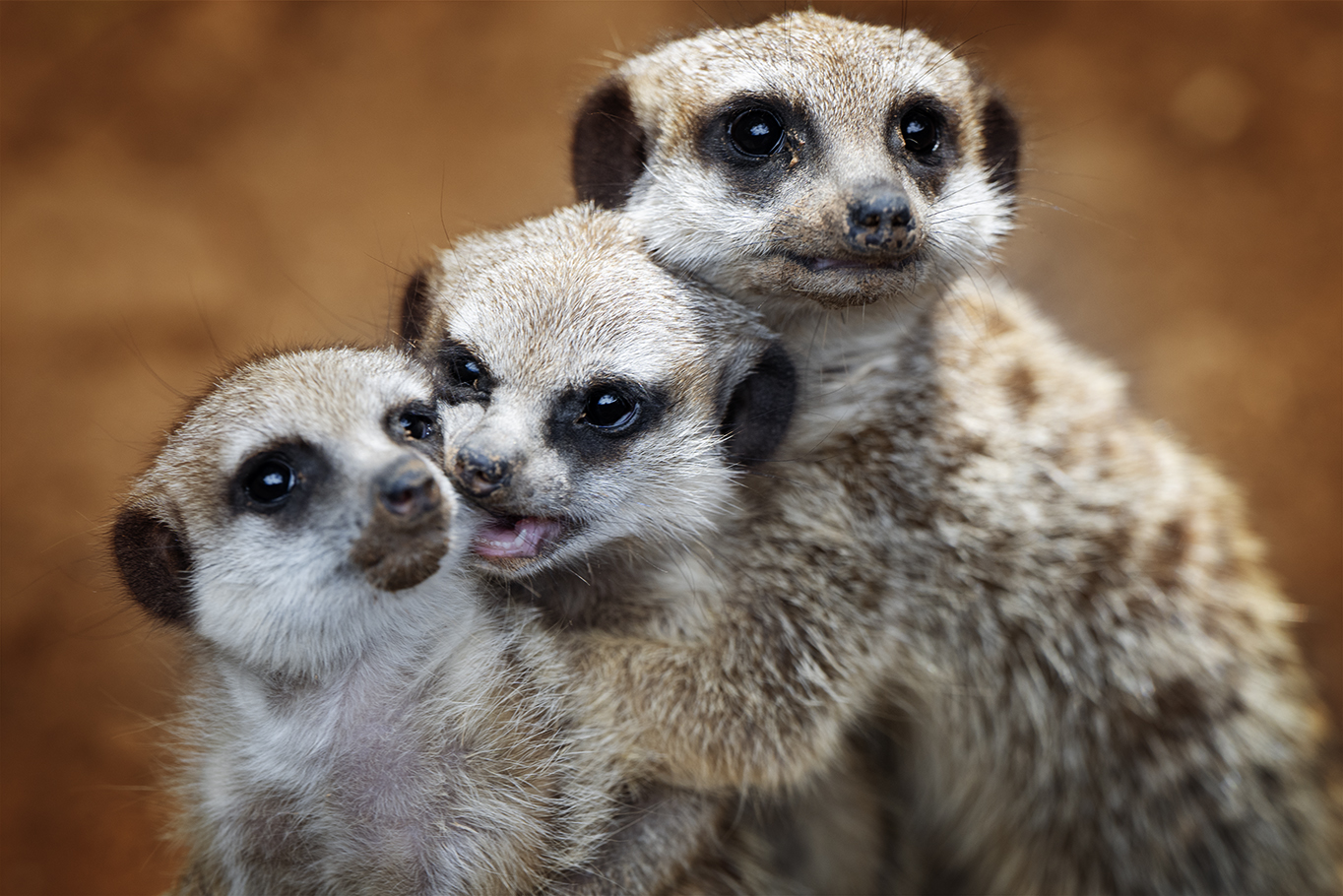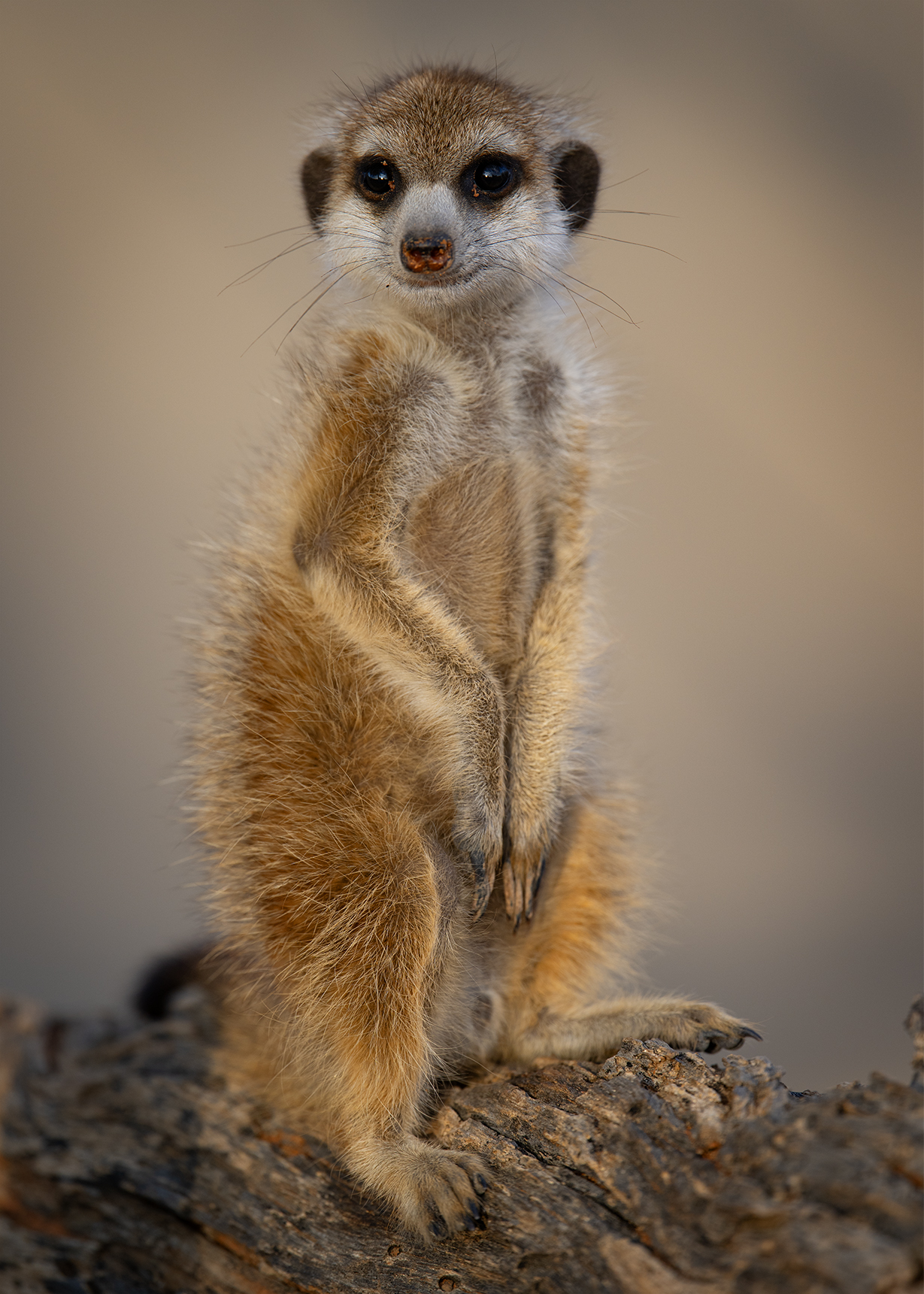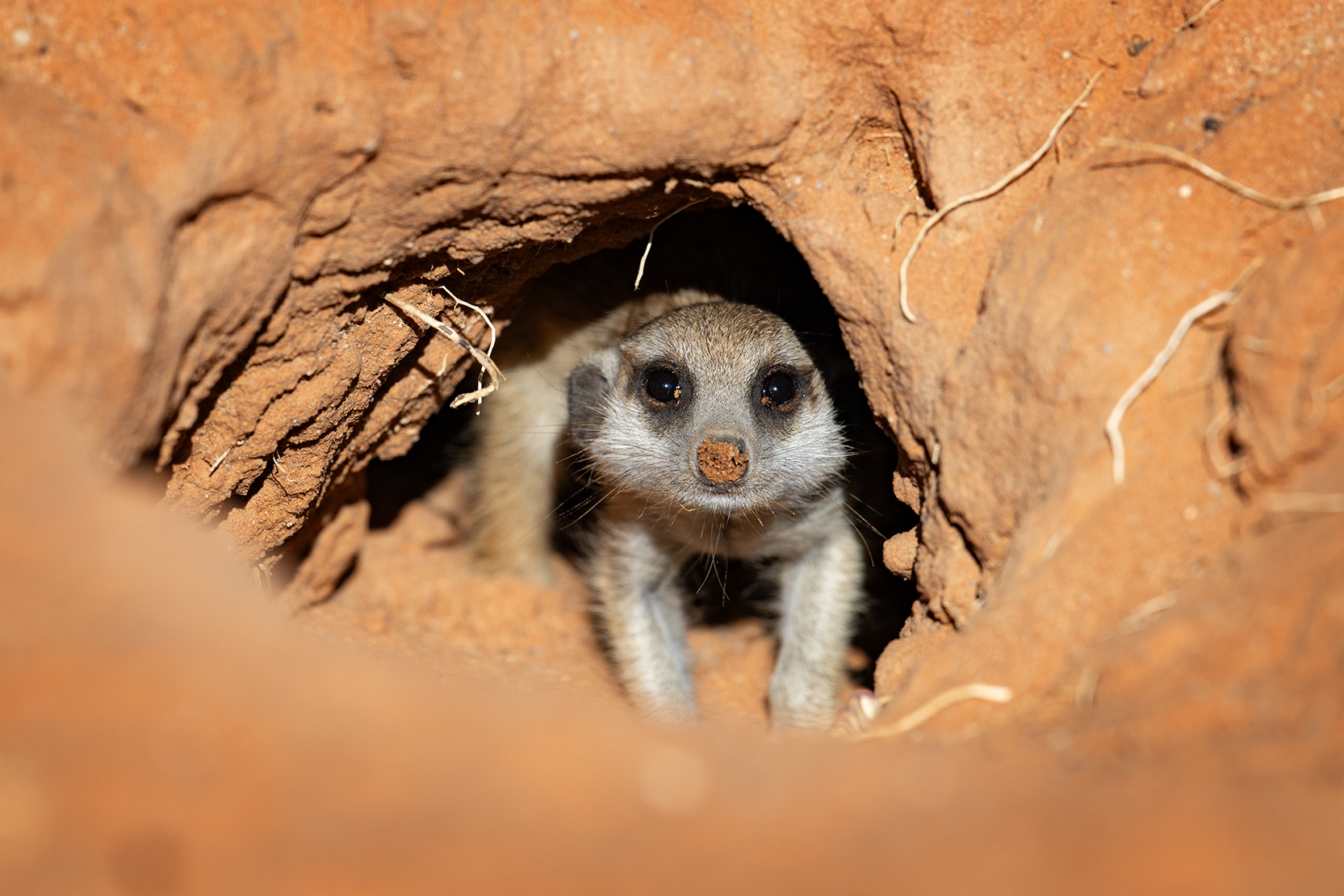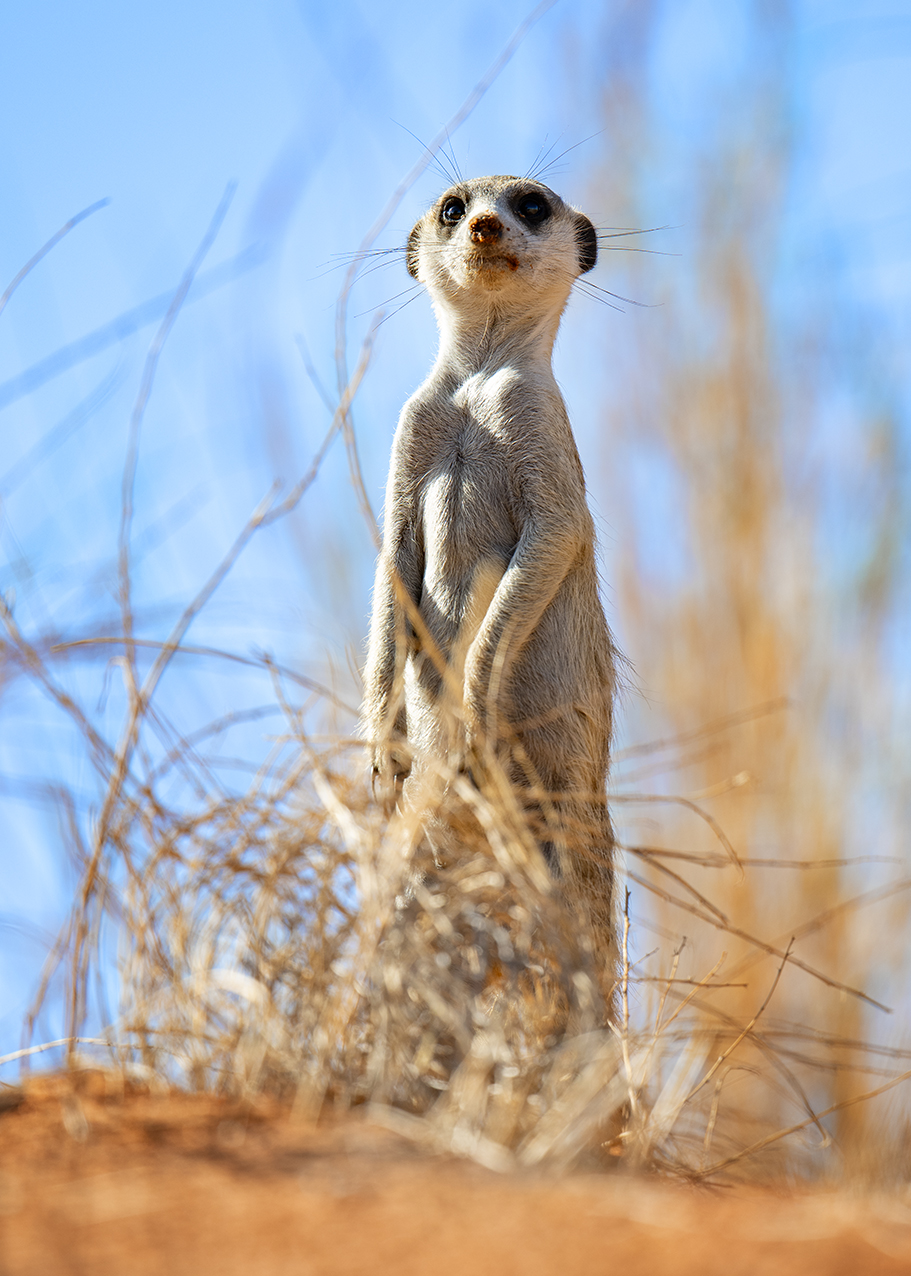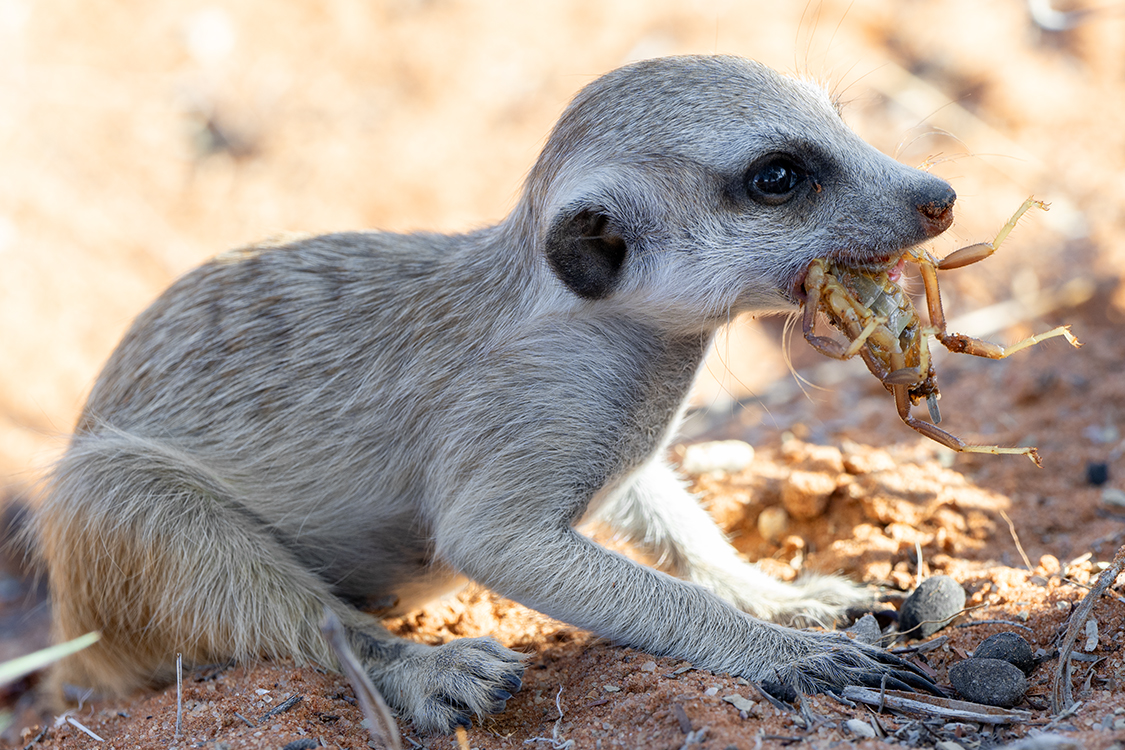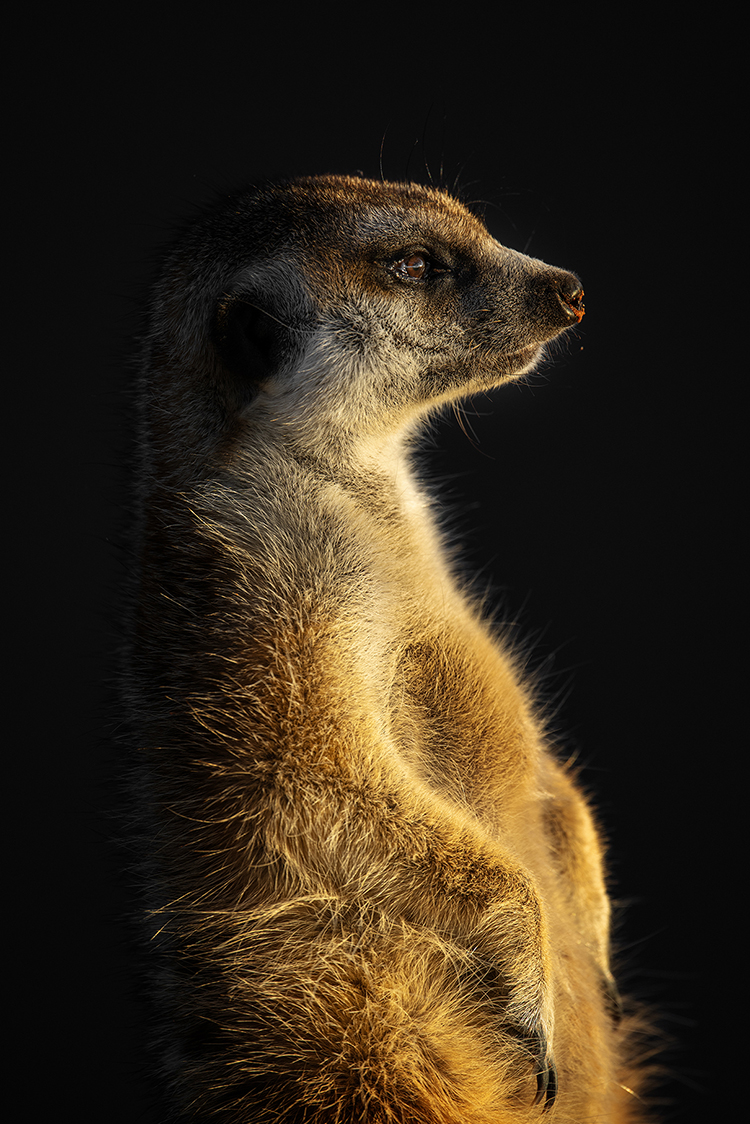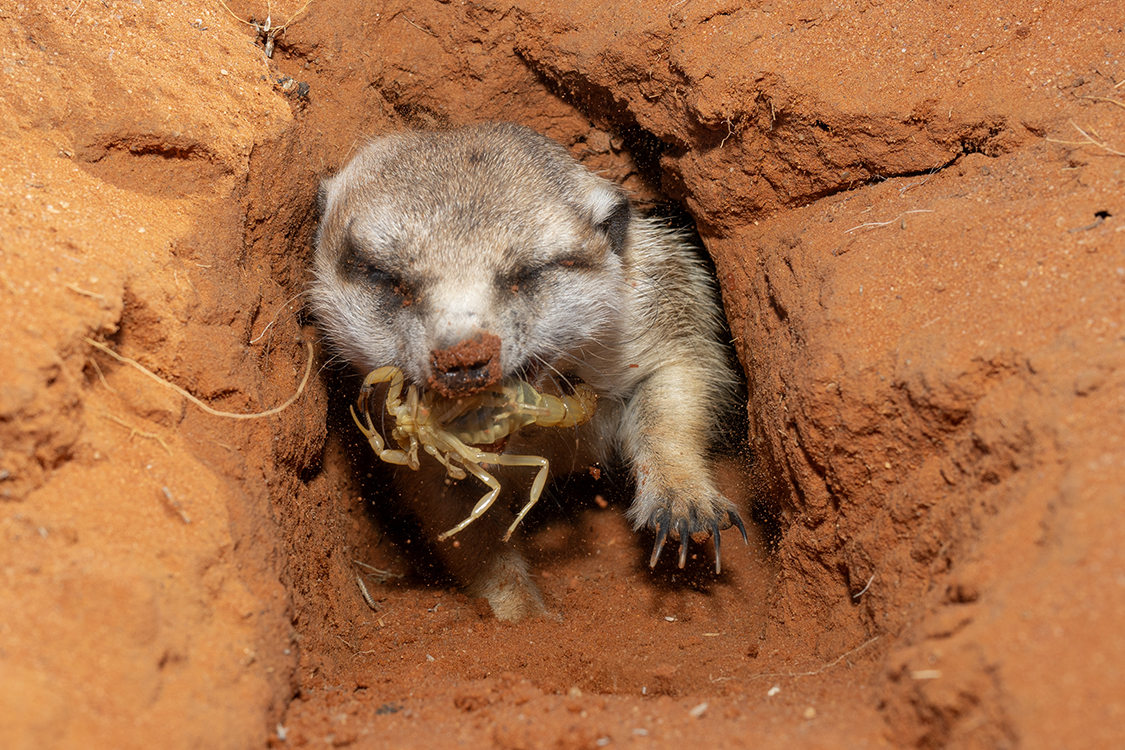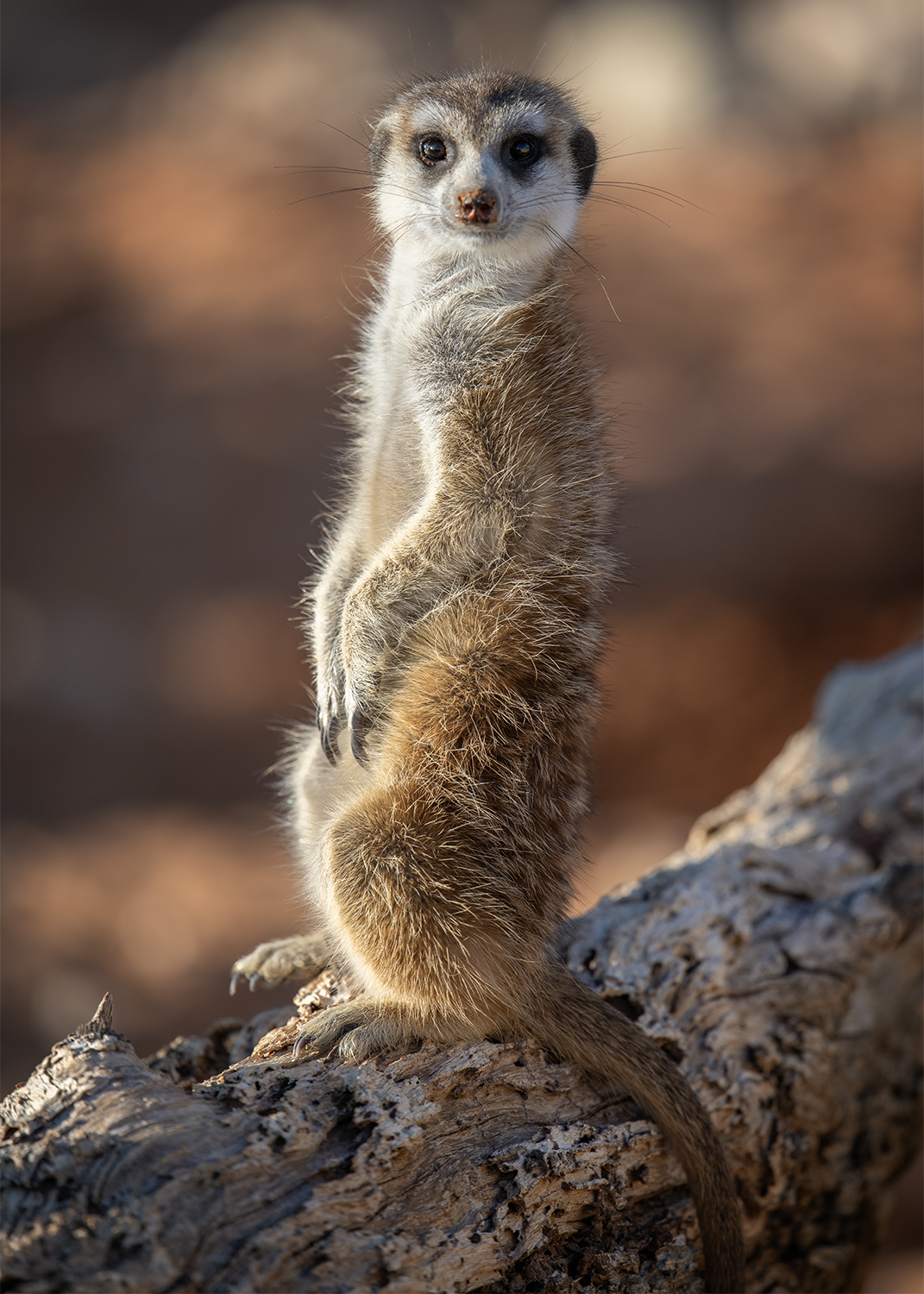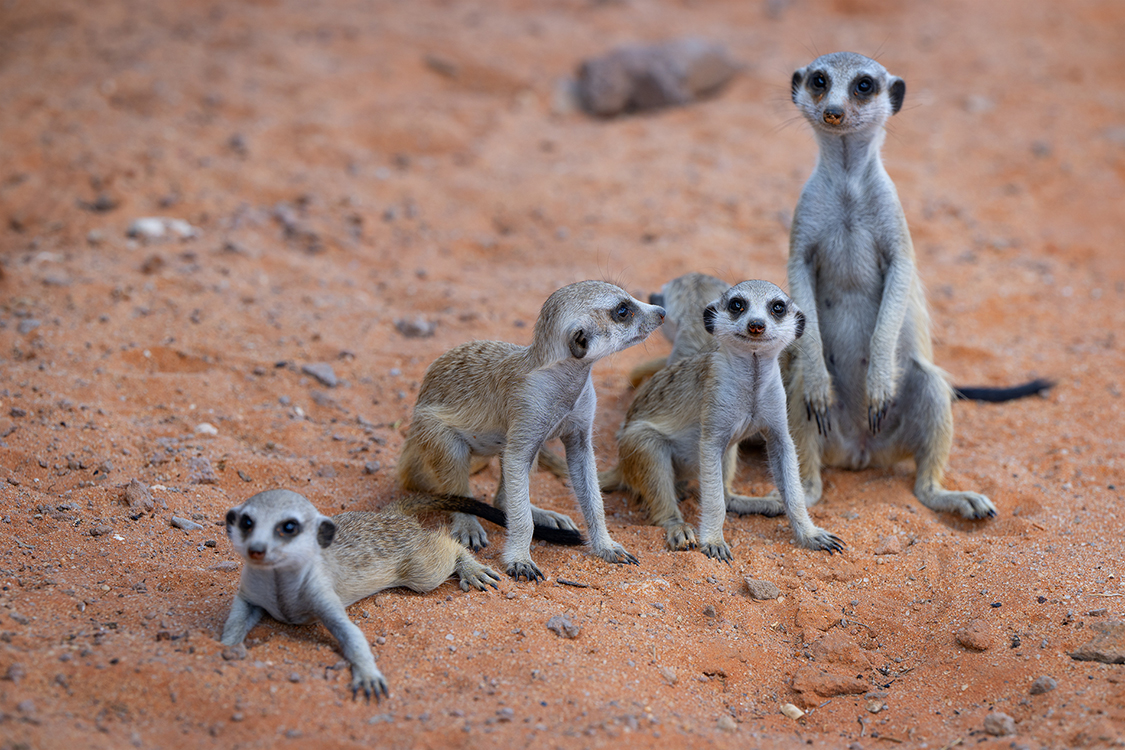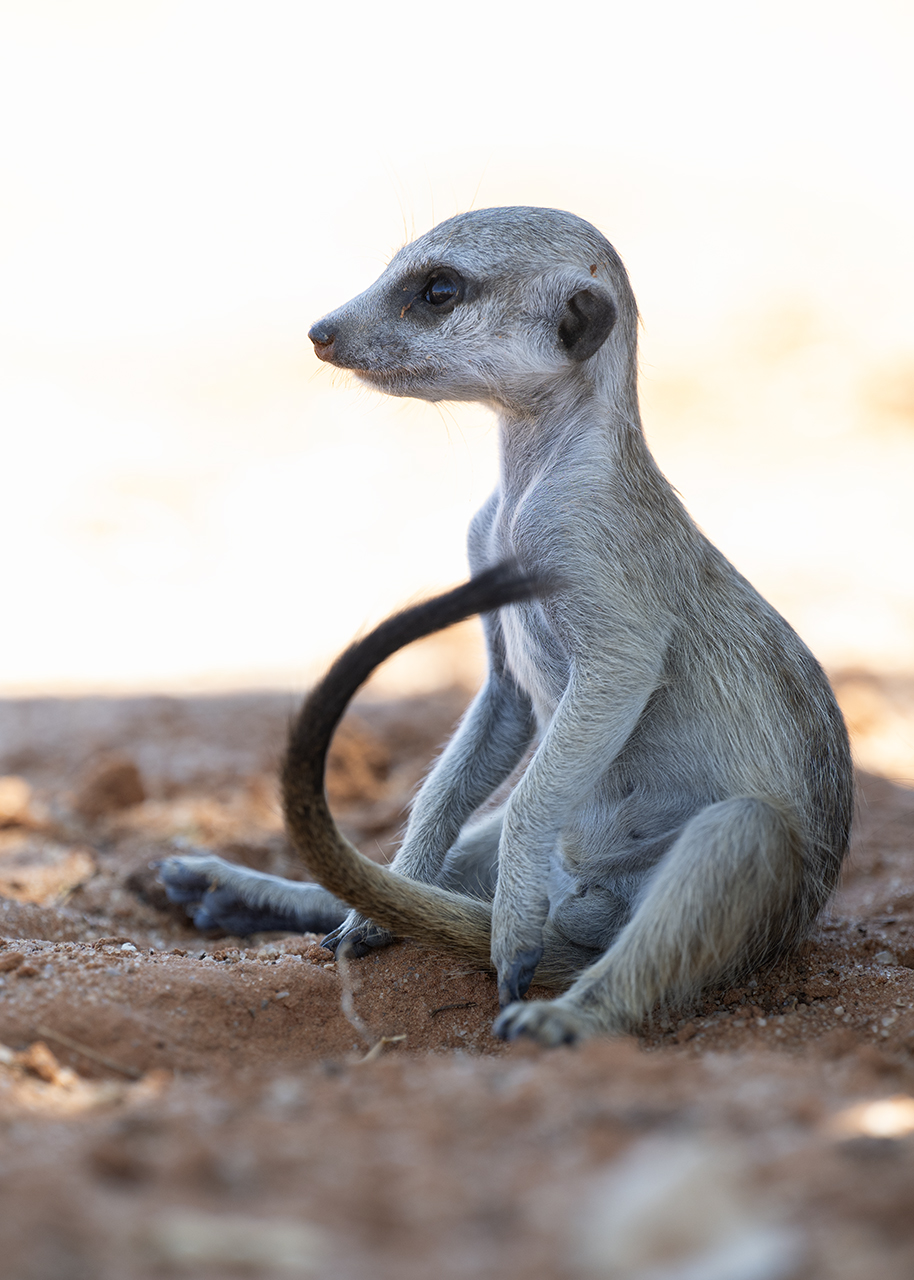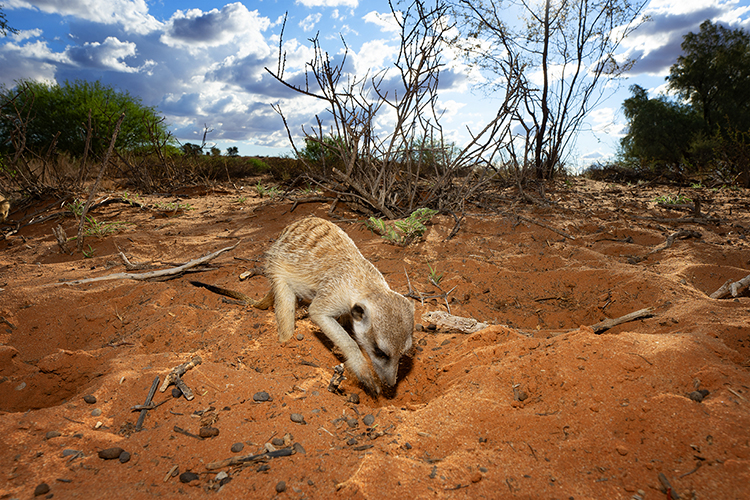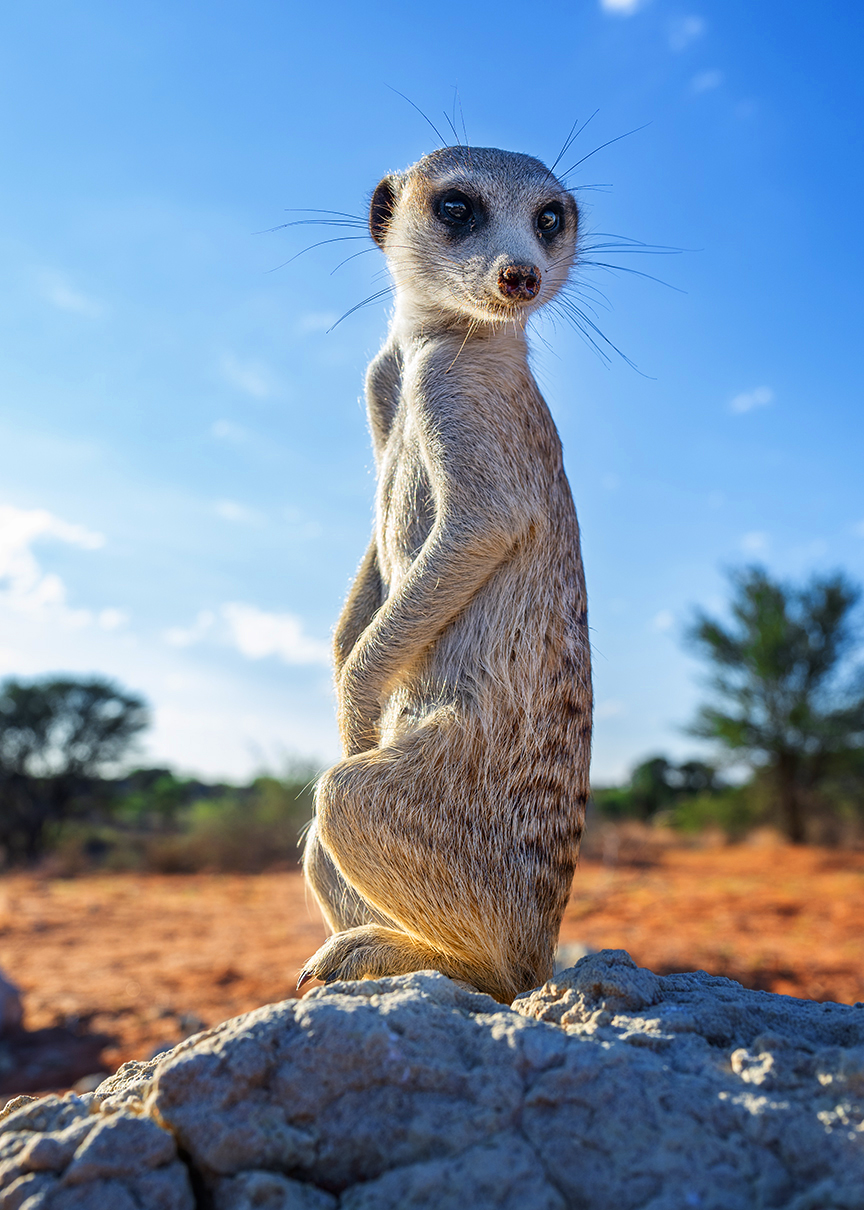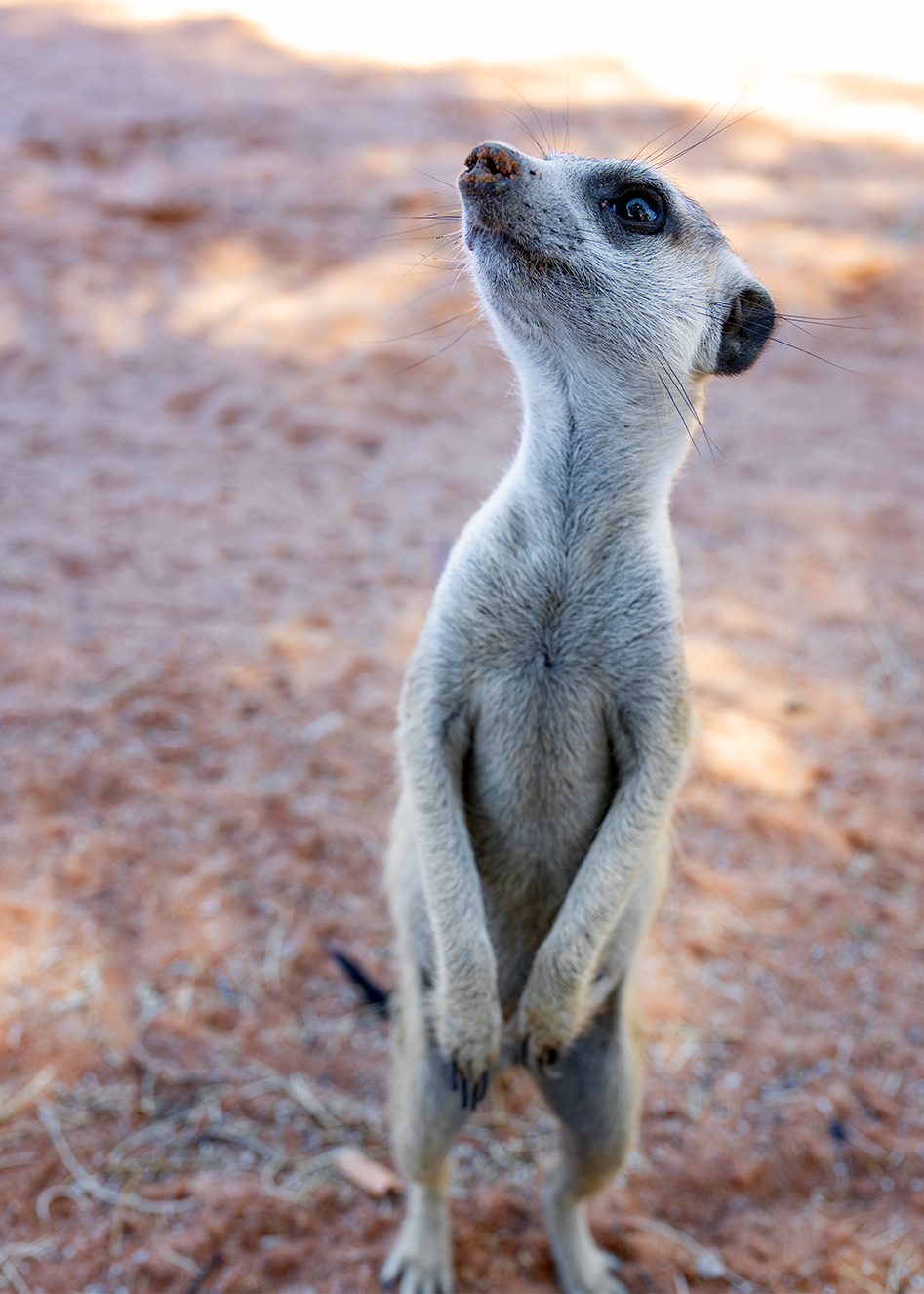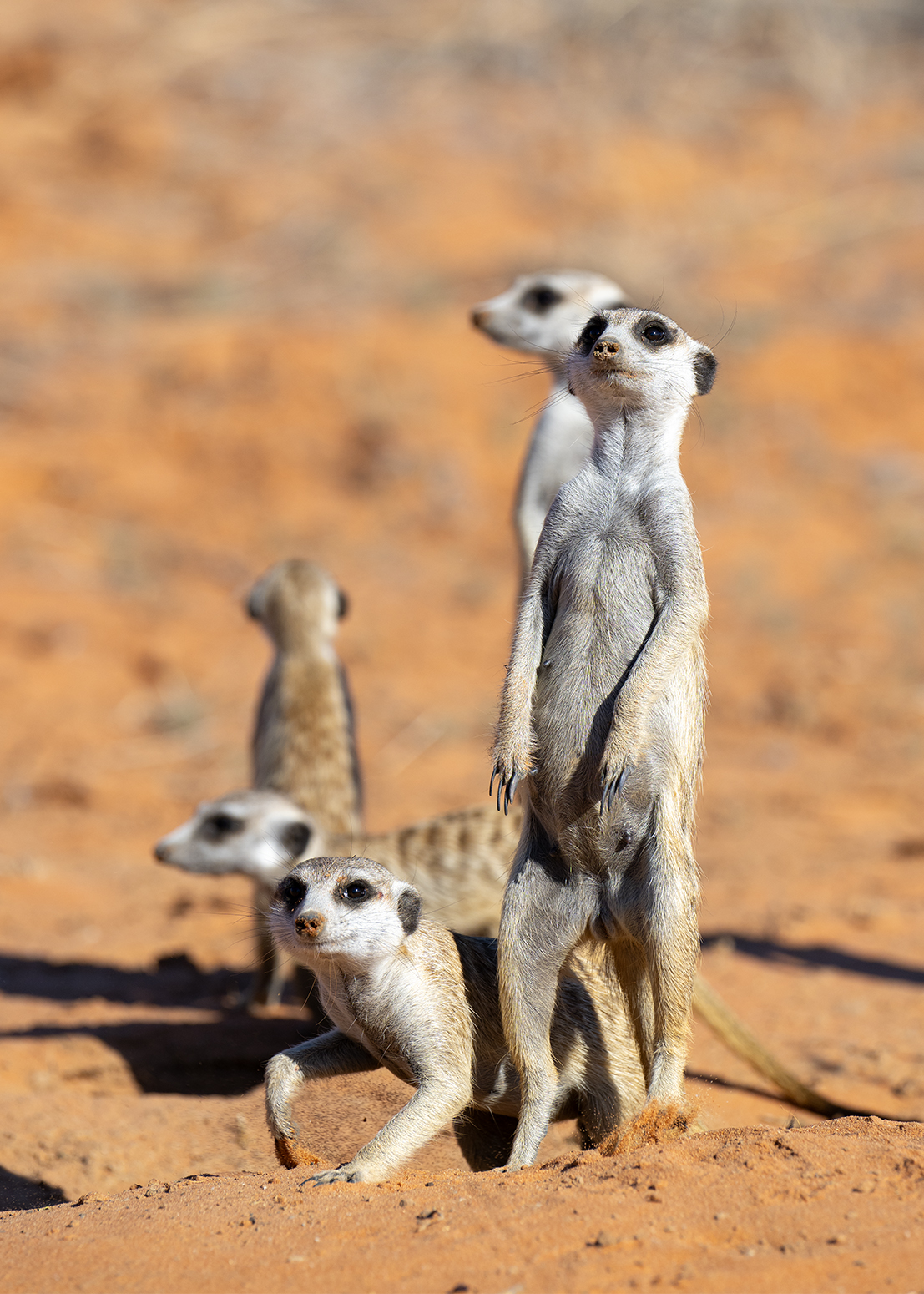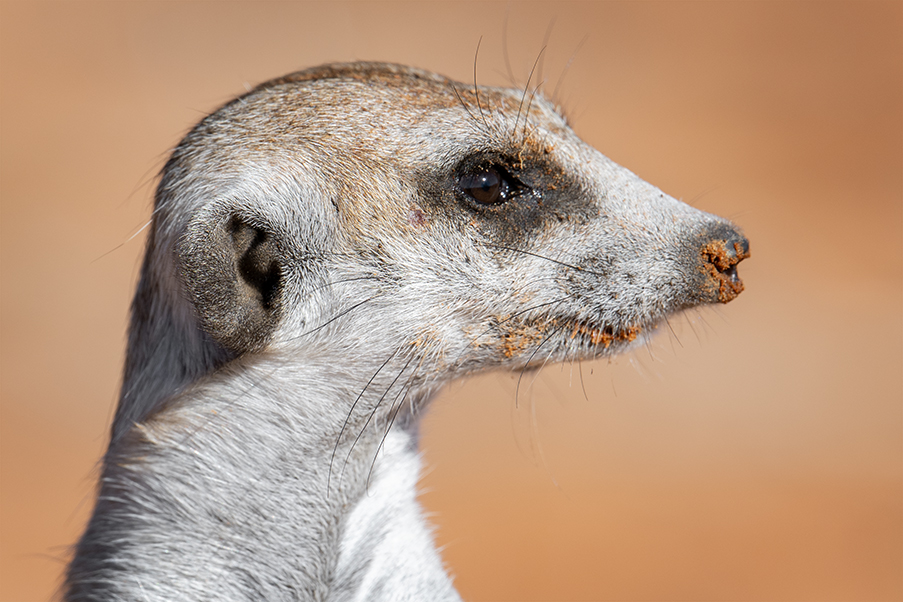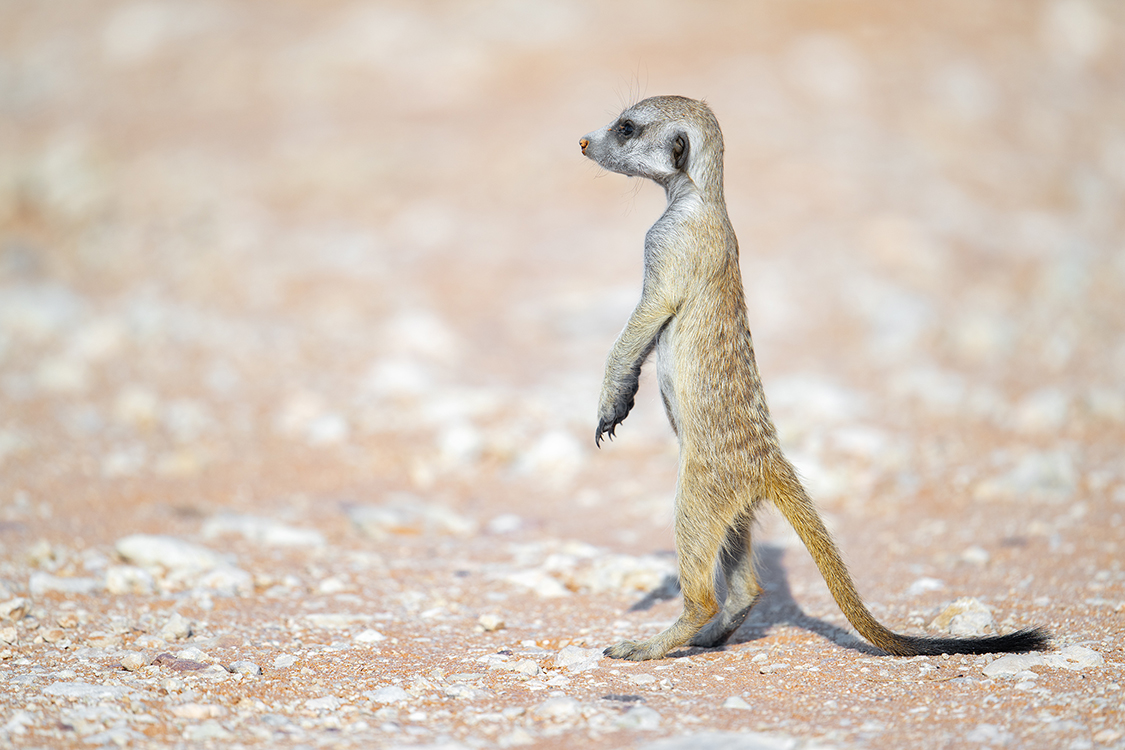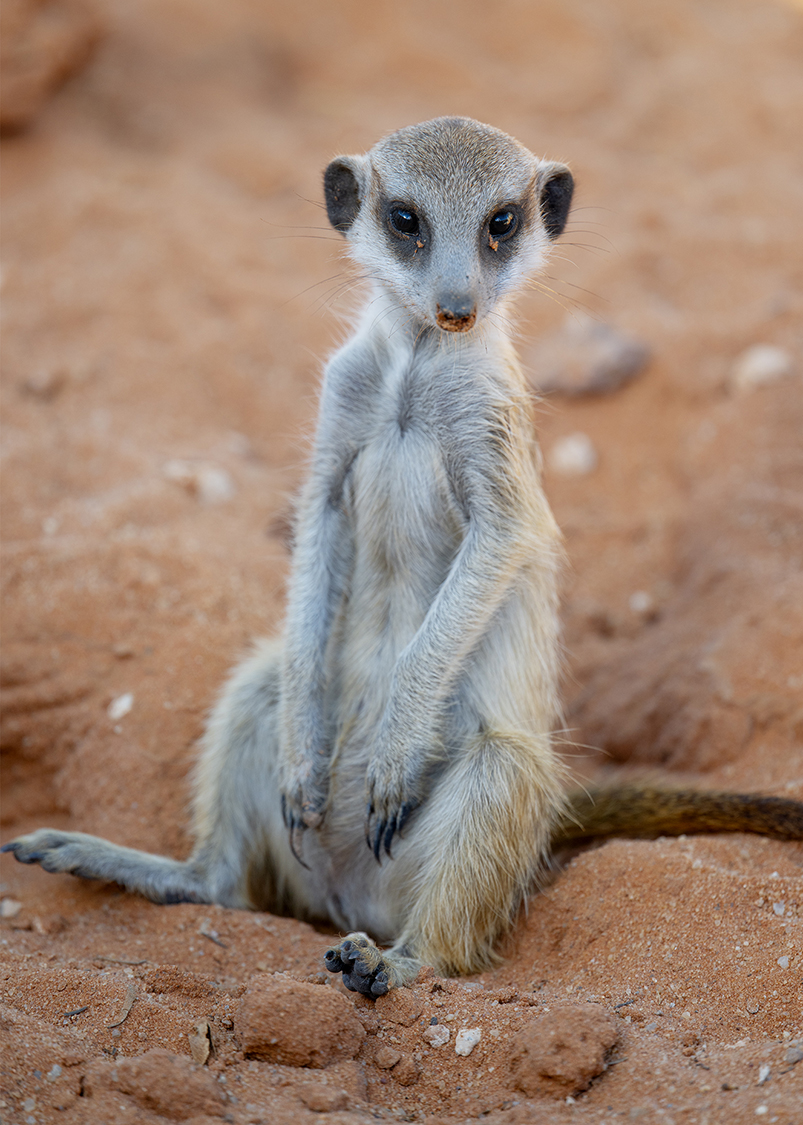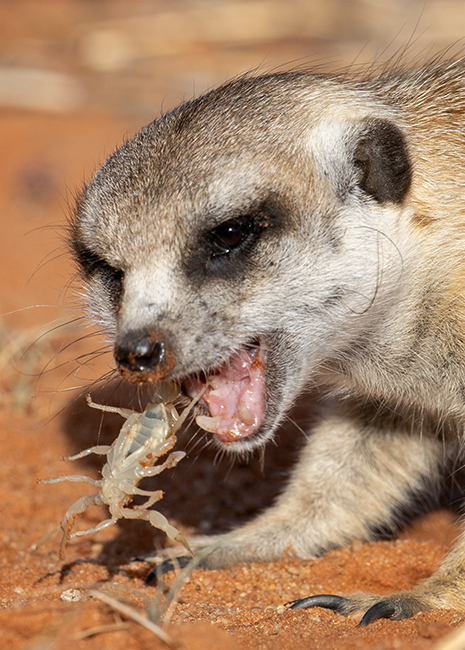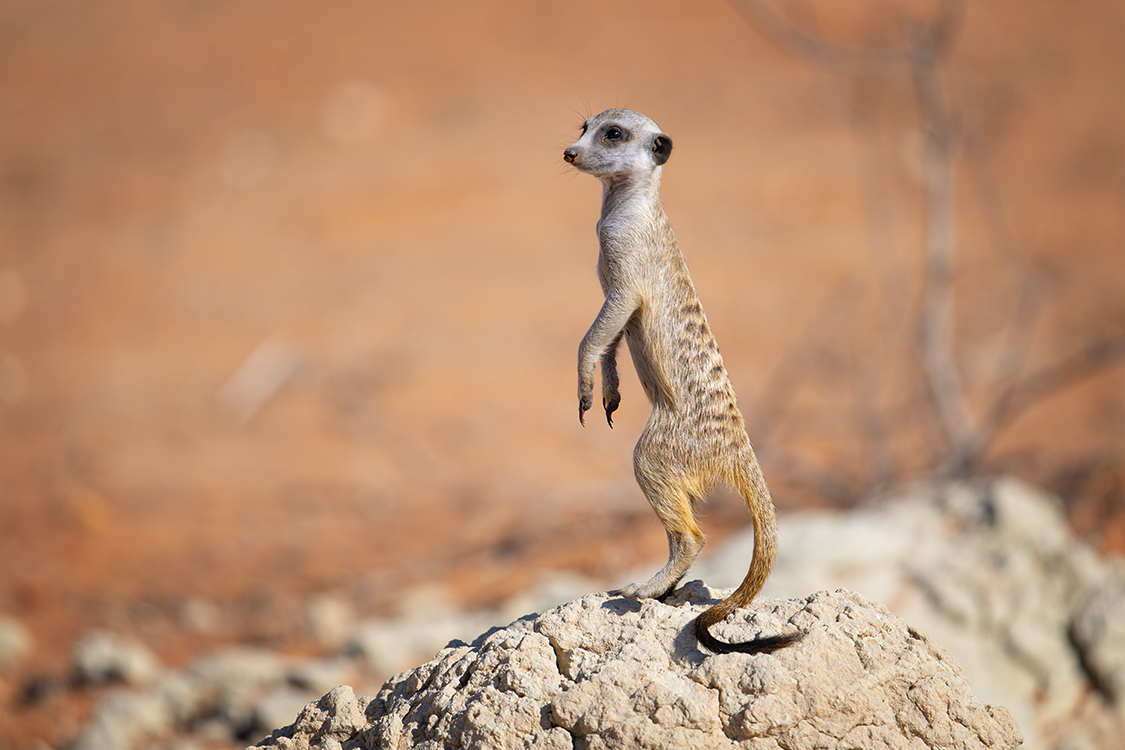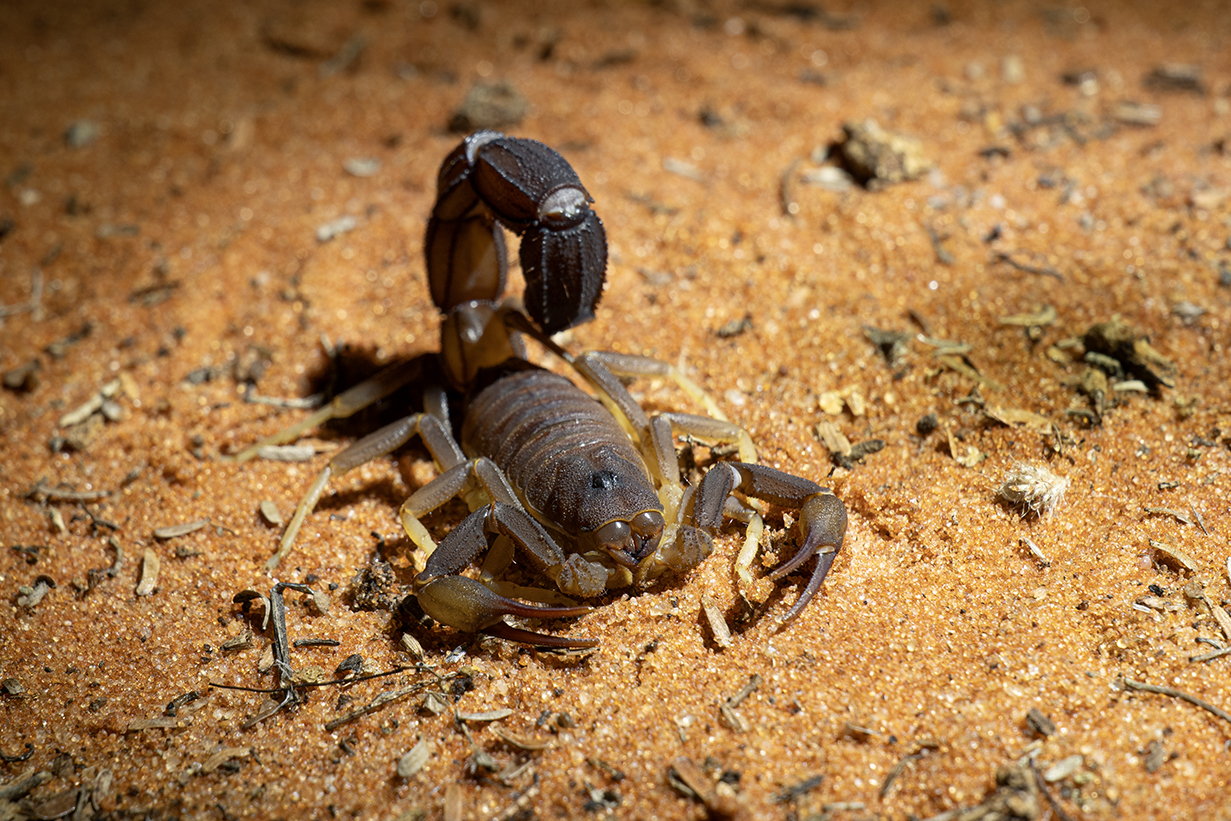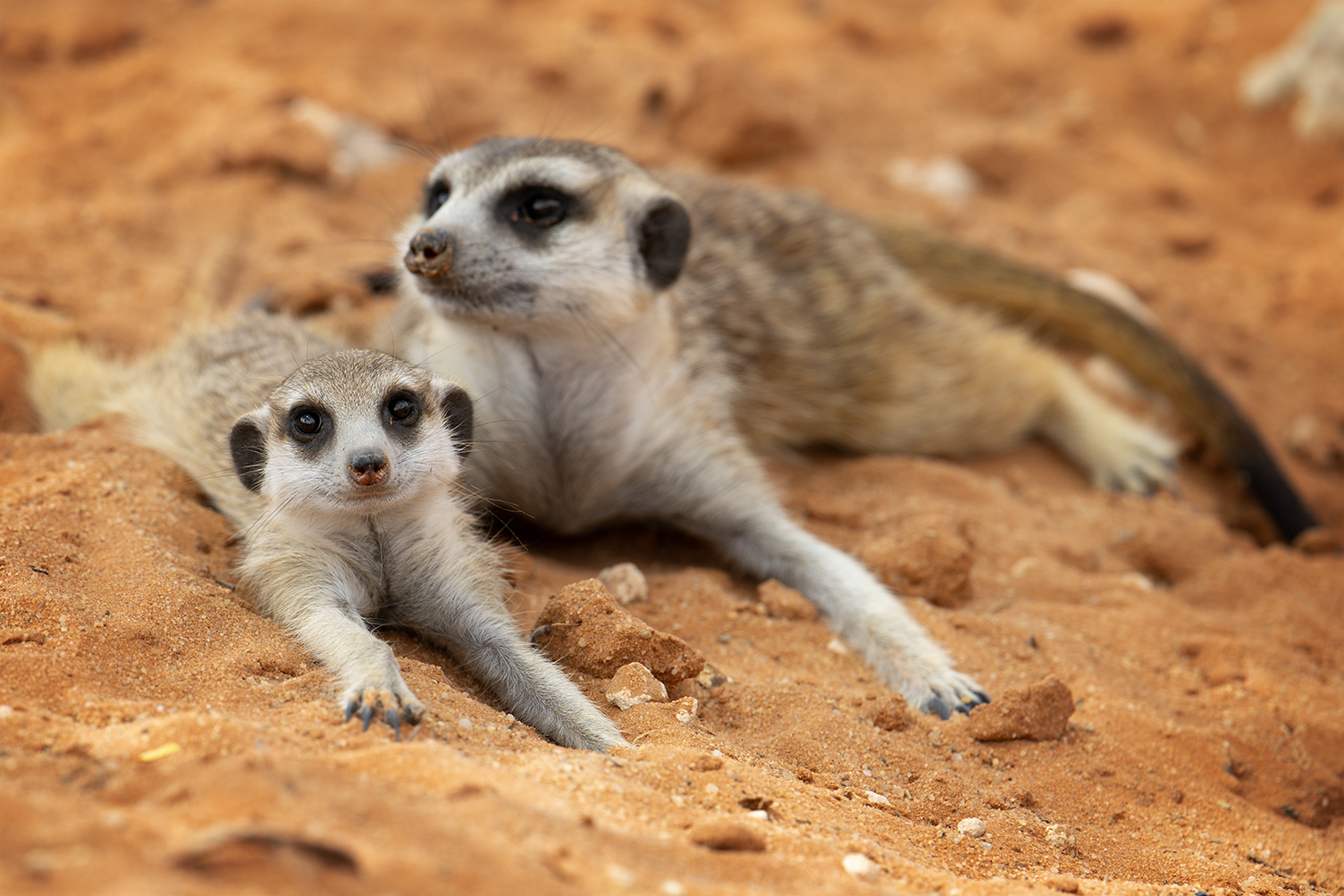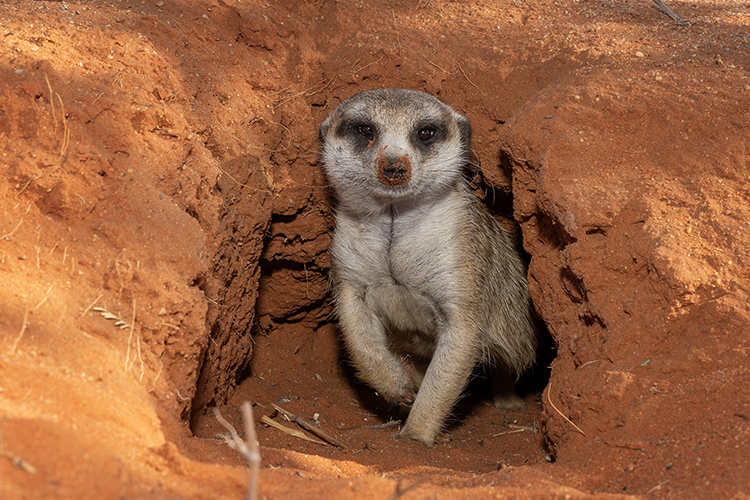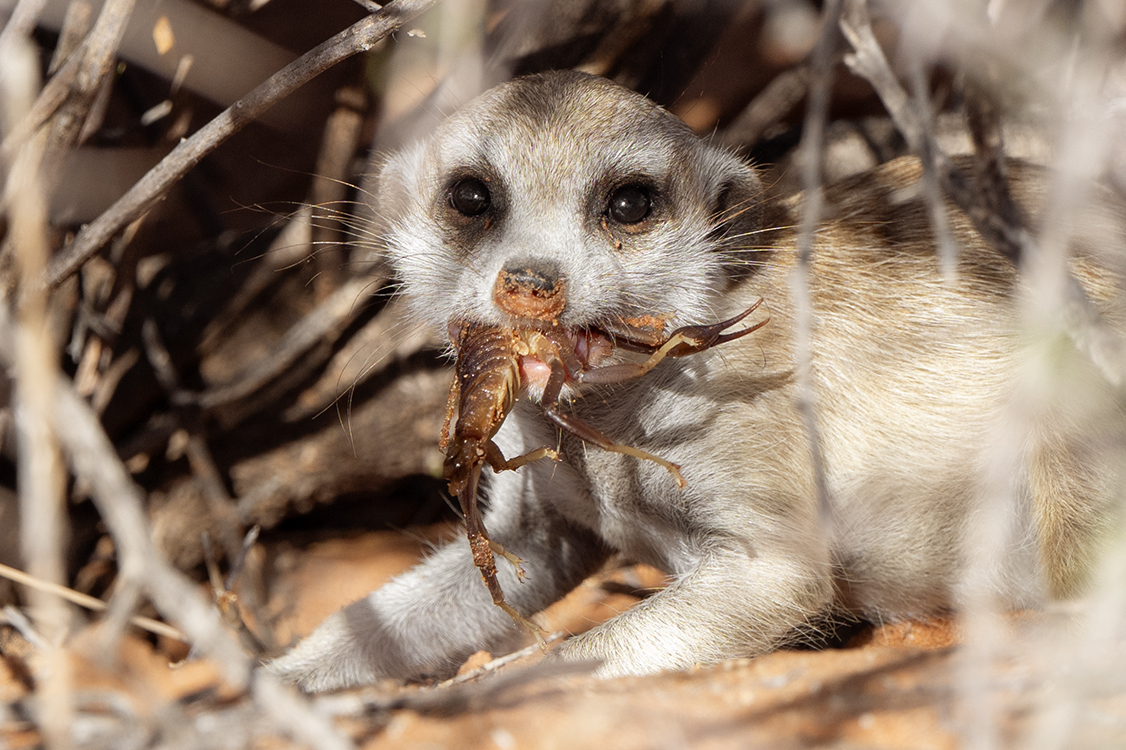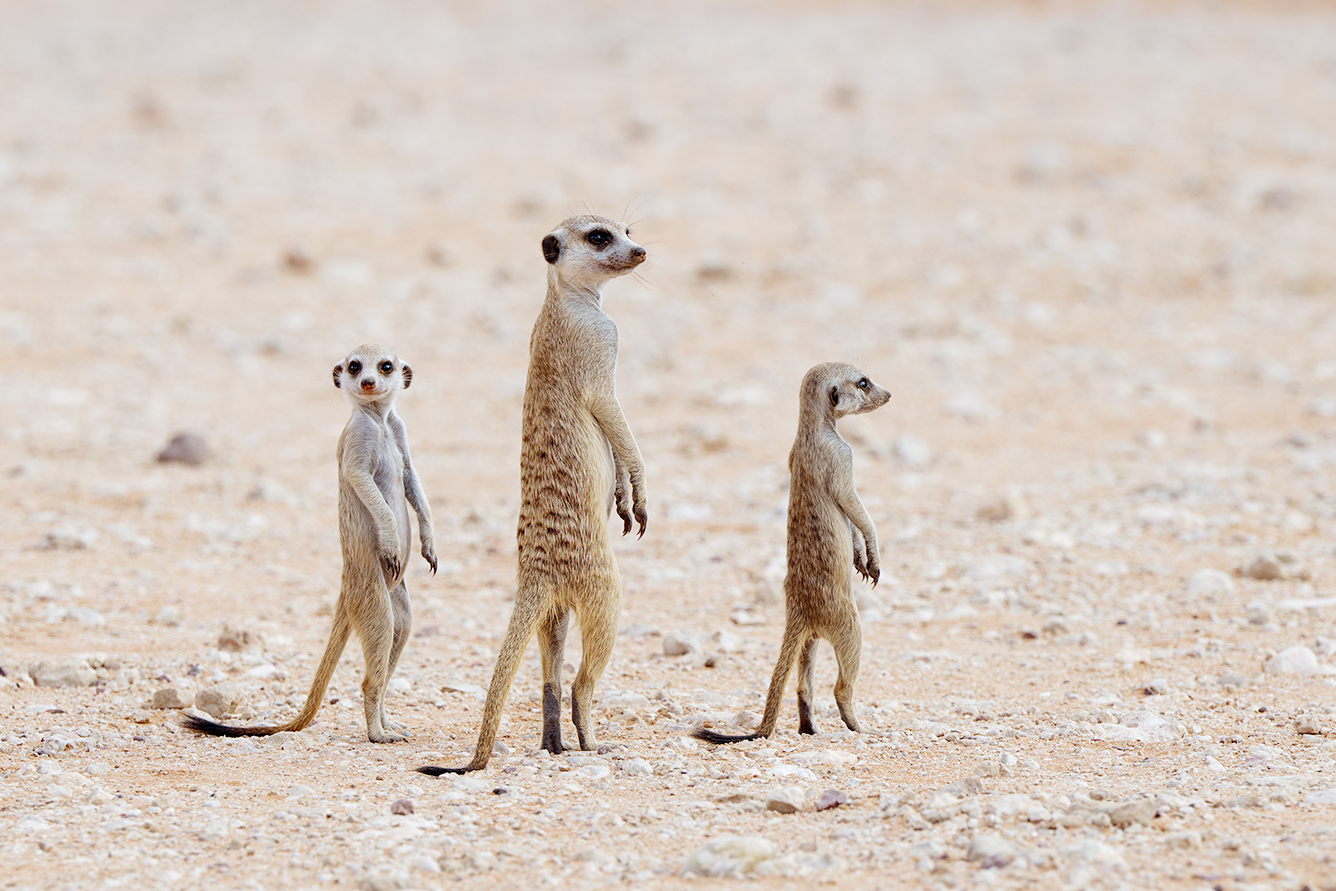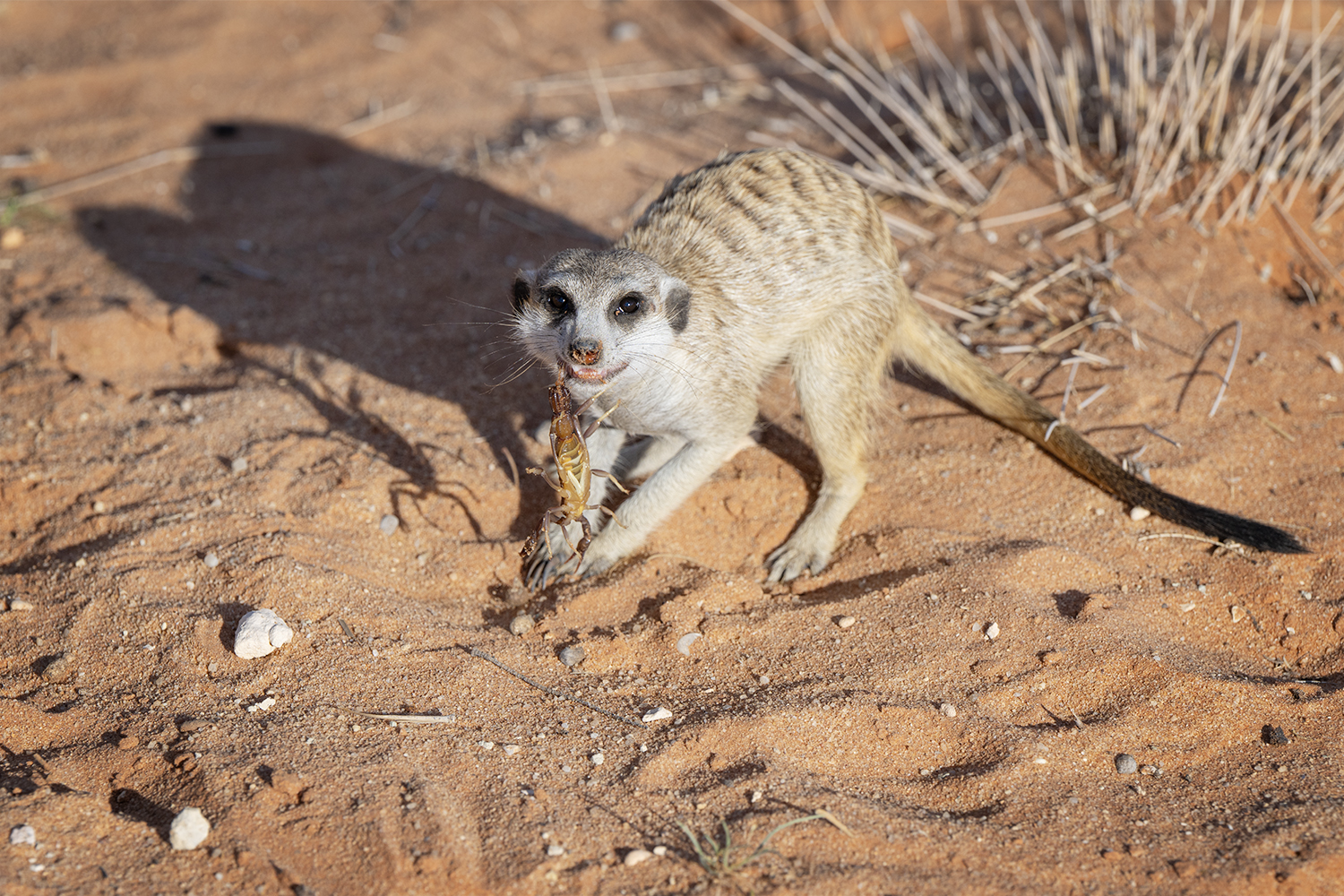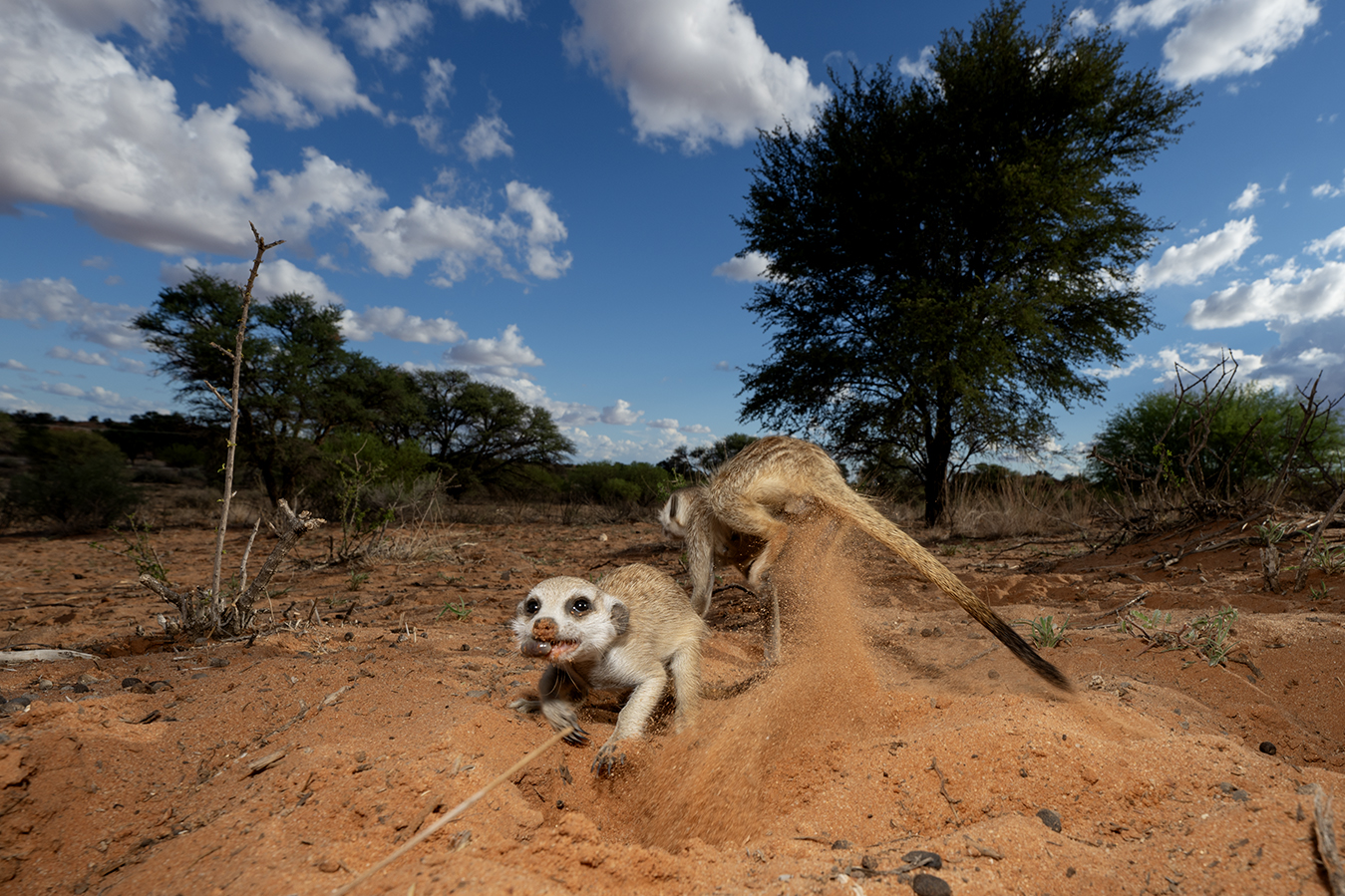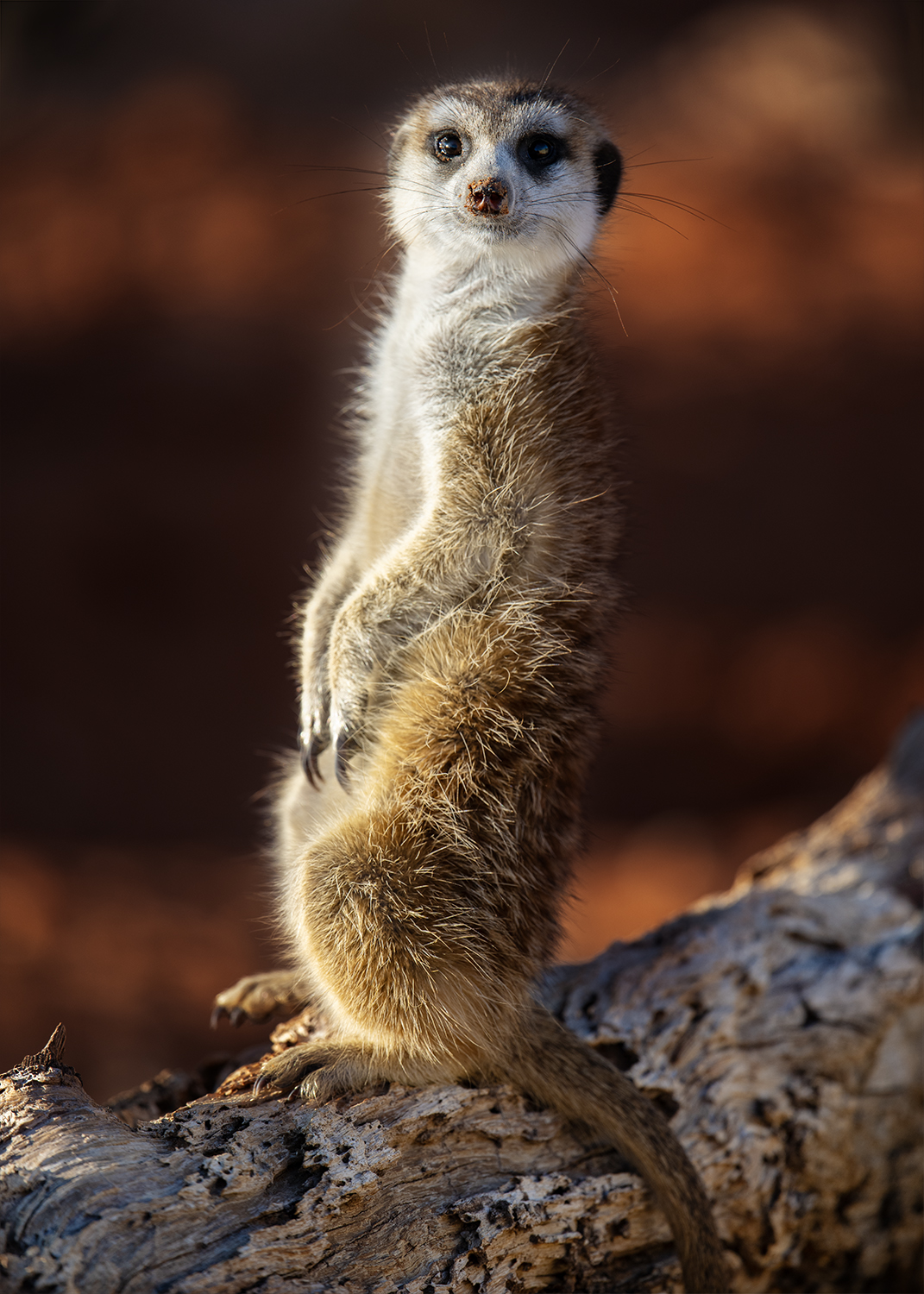Nikon Z9, Nikkor Z 24-70mm f/2.8 S. At f2.8 , 1/500 ISO 125
“Kalahari Meerkats: The Clan Of The Sands”
The Kalahari
Solitude, long gravel roads, scorching temperatures, and the never-ending anticipation of when or if a black-maned lion will appear and cross the road in front of the car. The Kalahari Basin is the largest unbroken expanse of sand on Earth—a vast and untamed wilderness that stretches across Southern Africa. Covering nearly 900,000 square kilometres, this semi-arid sandy savanna extends across much of Botswana and into parts of Namibia and South Africa.
The word Kalahari originates from the Tswana word “Kgala”, meaning “the great thirst,” or “Kgalagadi,” which translates to “a waterless place. Despite being called a desert, the Kalahari is not a true desert in the traditional sense—it receives more rainfall than most deserts, allowing for unique ecosystems and wildlife.
Beneath the scorching Kalahari sun, a small, tight-knit clan of meerkats emerges from their burrow, their beady-eyes scanning the terrain for threats. These charismatic creatures, often mistaken for cuddly pets, live by a complex social code—each member playing a vital role in the group’s survival. As I document their world, I witness their playful antics, coordinated foraging missions, and relentless vigilance against lurking predators.
But beyond their charm lies a harsher reality—many fall victim to the exotic pet trade, ripped from the only life they know. Alone in captivity, a meerkat is not the fearless sentry of the desert but a lost soul stripped of its family bonds and purpose. This is their story—the untamed beauty of life in the wild and the heartbreaking truth of those who are taken from it.
This was no ordinary assignment, and it would lead me into the heart of something extraordinary: The Kalahari Trails, a Meerkat Sanctuary.
What began as a simple quest of this remarkable creature’s world soon became a unique experience that connected me to a family legacy and the unbreakable bonds of the wild.
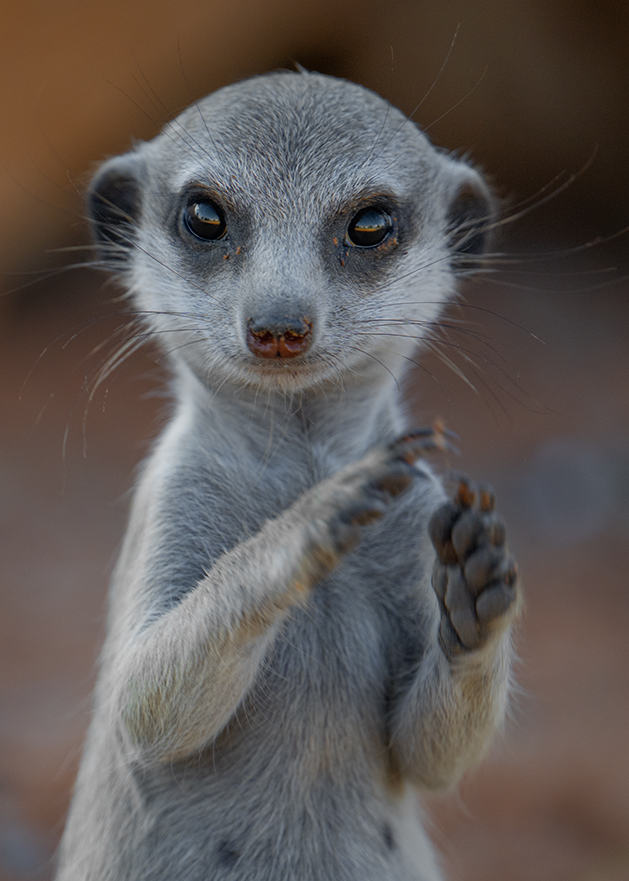
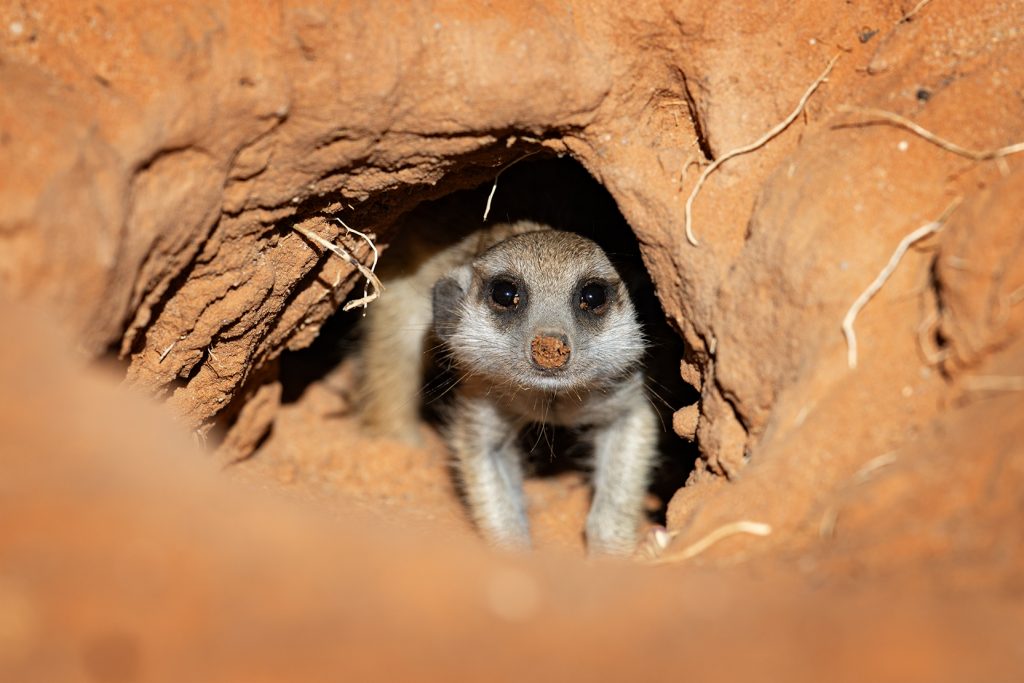
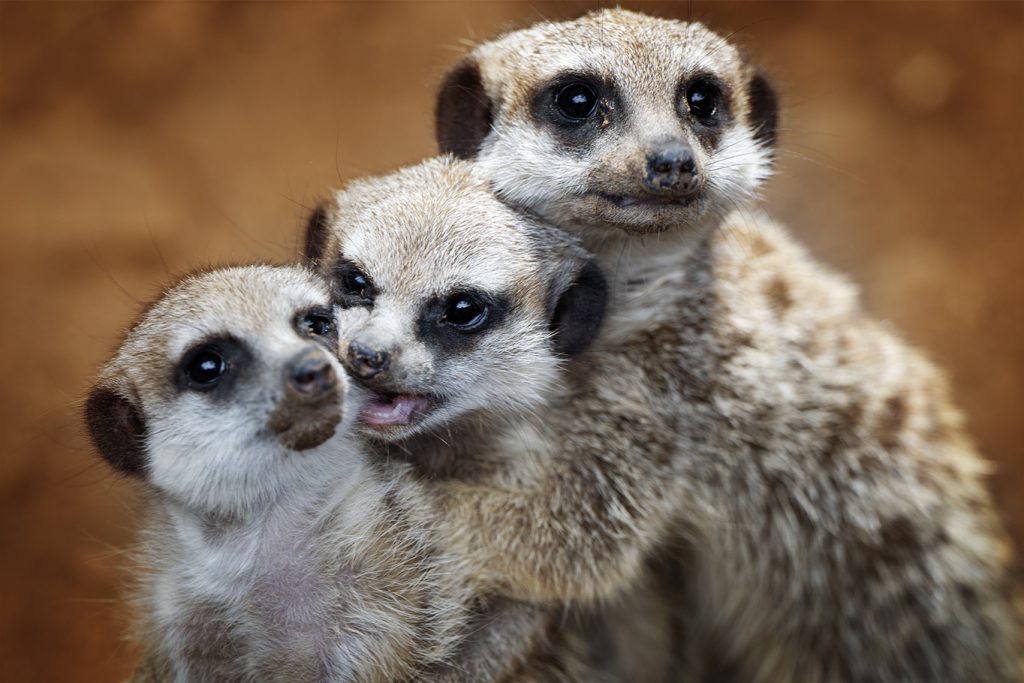
The Meerkat Guardian: A Legacy in the Kalahari
The Kalahari has a way of pulling people in, wrapping them in its vast silence, its fiery dunes, and its untamed spirit. It doesn’t just invite—it claims those who genuinely see it. For Professor Anne Rasa, that call was undeniable.
Professor Anne first set eyes on the land that would later become Kalahari Trails while still working at Bonn University. Something about the place gripped her heart. Each time she passed the farm, she stopped to inquire about buying it. And each time, the answer was no. But Anne was not one to give up easily. She understood persistence—after all, she had spent years studying the intricate hierarchies of mongoose clans. Then, in 1997, her patience was rewarded. The farm was finally hers.
But dreams rarely come pre-packaged in perfection. The property was in ruins. Her son, Richard Rasa-Phillips, remembers the day they first arrived—a bumpy ride along a dusty road, shaking in their seats as they approached their new home. What awaited them was nothing short of a challenge. The main house had been left to decay, and someone had even built a fire in the middle of the lounge, ignoring the fireplace entirely.
That first night, Richard slept under the stars in their bakkie [pickup truck], while his mother and sister took refuge in what remained of the living room.
For a while, Anne continued her research at Bonn University while renovations took place. It wasn’t until December 2000 that she finally moved to the farm full-time, ready to bring her vision to life.
"In the Kalahari, true discovery happens when you slow down. And if you're lucky, you might find yourself watching a meerkat clan emerge at sunrise, standing guard against the endless horizon—wild, free, and exactly where they belong."
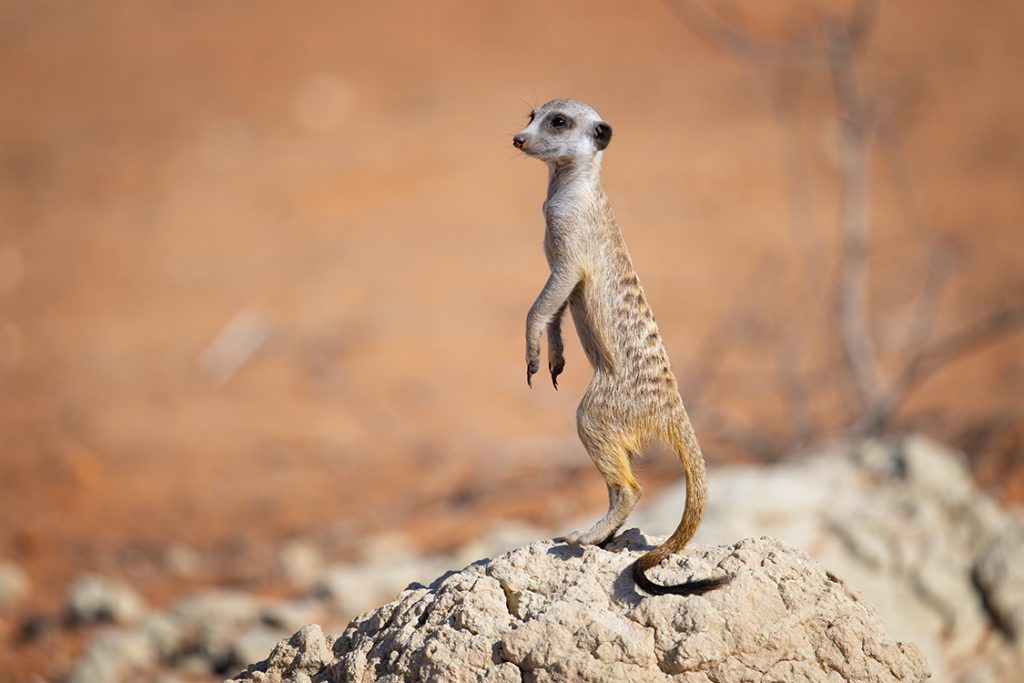
A Meerkat Sanctuary is Born
One day, a neighbour brought Anne an injured meerkat. With all her experience working with dwarf mongooses, Anne knew exactly how to care for it. She nursed it back to health and released it. Then another meerkat arrived. And another. Before long, Northern Cape authorities took notice. They approached her with a question that would define the future of Kalahari Trails:
Would she take on the role of the official Northern Cape Meerkat Sanctuary?
Anne didn’t hesitate.
She had already witnessed firsthand the damage the exotic pet trade was causing. People would buy baby meerkats, enchanted by their playful nature, only to realise later that these wild animals didn’t belong in a home. Most were abandoned or neglected when they became too difficult to handle. Anne made it her mission to educate the public, speaking out against keeping meerkats as pets.
But Kalahari Trails was never just about meerkats. Anne envisioned a place where people could experience the Kalahari in its purest form. She started guided walks, teaching visitors about the delicate balance of desert life—the way each creature, no matter how small, played a crucial role in this harsh but beautiful ecosystem.
The sanctuary became a haven not just for meerkats but also for anyone seeking to understand the rhythms of the Kalahari.
When the professor fell seriously ill in early 2020, Richard made a decision that few could make so easily. He walked away from the high-paced world of film production and returned to Kalahari Trails to help her.
Anne passed away on November 15, 2020, leaving behind not just a sanctuary but a legacy.
Continuing the Legacy
Now at the helm of Kalahari Trails, Richard has embraced the quiet beauty of the desert. He understands what his mother saw all those years ago—the magic of this place, the sense of peace that only the Kalahari can offer.
His dream is to continue what Anne started. To keep Kalahari Trails a sanctuary, not just for meerkats, but for those seeking to reconnect with nature. Unlike traditional game reserves where visitors stay inside vehicles, here, you walk. You feel the warm sand under your feet, watch the tiny tracks left by nocturnal creatures, and listen to the wind shift through the dunes.
In the Kalahari, true discovery happens when you slow down. And if you’re lucky, you might find yourself watching a meerkat clan emerge at sunrise, standing guard against the endless horizon—wild, free, and exactly where they belong.
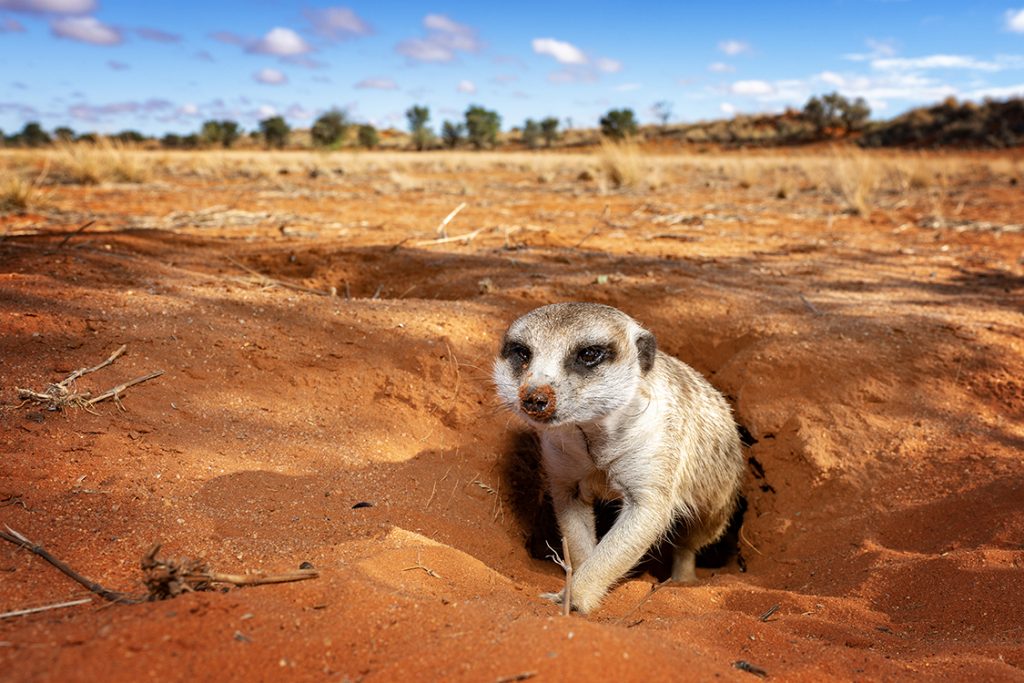
Capturing The Wild Gang Madness With Nikon
This wasn’t my first time at the Kalahari Trails Meerkat Sanctuary. Back in 2023, while exploring the Transfrontier Park, I made a brief stop and met Mareli van der Berg, the sanctuary’s caretaker. Sitting in the golden afternoon light, she spoke about the meerkats and her deep love for the desert. Something about her passion lingered with me, and before leaving, I made her a promise—I would return for a more meaningful experience. Now, I was fulfilling that promise.
Since July 2020, Mareli has devoted herself to carrying forward the legacy of Professor Anne Rasa, becoming the last person the renowned scientist mentored one-on-one before her passing. Guided by the professor’s teachings, she now introduces visitors to the magic of the Kalahari—its history, its resilient flora, the cryptic messages left in the sand by creatures of the night, the silent menace of venomous scorpions, and, of course, its charismatic meerkats. A lifelong student of the desert, Mareli recently achieved her FGASA Level 3 qualification, yet she remains restless, knowing the Kalahari always has more stories to tell.
A Fast-Paced World Through The Lens
Meerkats live in highly organised gangs, where each member plays a crucial role in the clan’s survival. These tightly bonded communities can consist of just a handful to over 30 individuals, working together like a well-oiled machine. Sentinels stand guard, scanning for predators; foragers dig tirelessly for food; babysitters care for the young; and scouts push the boundaries of their territory. Their interactions are a masterclass in teamwork, loyalty, and communication.
During my two-week stay, I shadowed a wild group of 16 meerkats, immersing myself in their world. Documenting their intricate social structure and unpredictable antics required gear that could keep up with their lightning-fast movements. The Nikon Z9, with its advanced subject detection and 120 fps burst mode, became my greatest ally in freezing the action-packed chaos. Paired with the NIKKOR Z 400mm f/4.5 VR S, I captured razor-sharp telephoto shots of sentinels scanning the desert for threats. The vibration reduction (VR) technology was invaluable in keeping the images crisp, even when tracking movement in handheld mode.
When the meerkats ventured closer, curiosity taking over, I switched to the Nikon Z8 with the NIKKOR Z 24-70mm f/2.8 S. This versatile lens allowed me to shoot at a comfortable mid-range, maintaining stunning sharpness and depth even in low light. The meerkats, undeterred by my presence, would often clamber over my equipment or sniff at my camera bag—offering once-in-a-lifetime close-ups. The silent shutter mode on the Z8 ensured I could document their interactions without startling them.
Light And Shadows In The Kalahari
Photographing in the Kalahari is both a privilege and a challenge. The harsh midday sun casts intense shadows, while the golden hours before sunset bathe everything in warm, ethereal hues. For wide environmental shots that showcased meerkats against their vast, arid home, I relied on the NIKKOR Z 14-24mm f/2.8 S. The edge-to-edge sharpness and fast f/2.8 aperture allowed me to play with depth of field while still preserving the grandeur of the landscape.
Low-light situations brought their own trials—especially when capturing the meerkats finding shelter under trees or their post-sunset stunts. The Nikon Speedlight SB-5000 became indispensable for subtle fill lighting, ensuring that I could highlight textures without disrupting their natural behaviours. A delicate balance had to be struck between artificial and ambient light, and the high-speed sync (HSS) capability made all the difference in maintaining natural tones in my images.
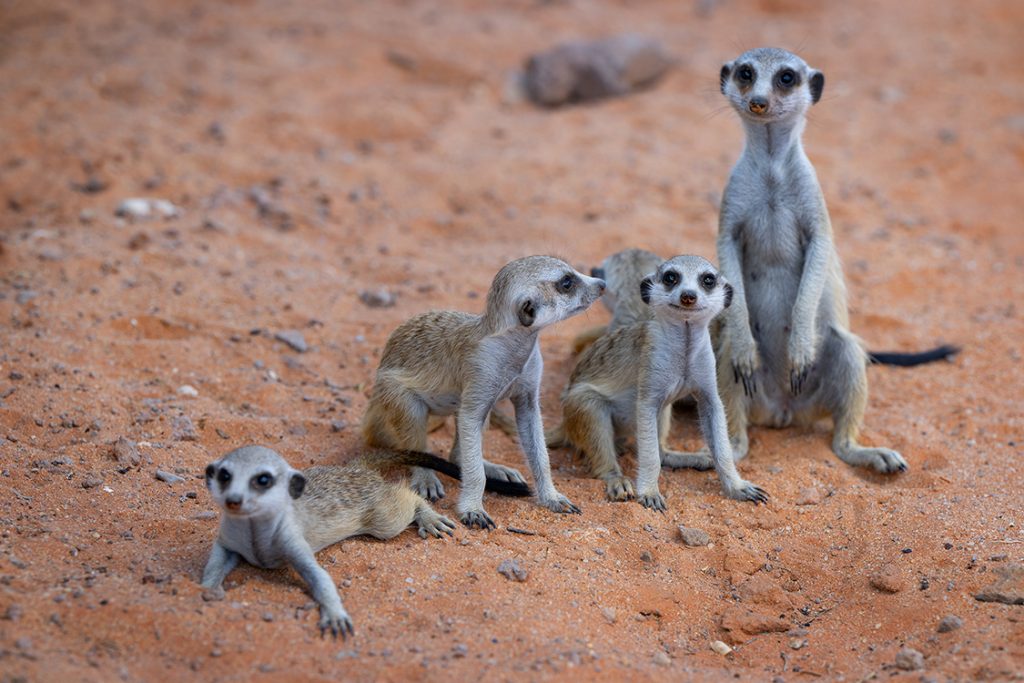
The Meerkat Matriarch
One meerkat stood out — ‘the matriarch’. She was clearly pregnant and carried herself with quiet confidence, her body language conveying a mix of authority and caution. This dominant female had a curious habit. She often took her gang across the border from South Africa into Botswana, disappearing for days at a time. Mareli believed she made these secretive journeys to reunite with her mate—the father of all her pups—but preferred the South African side of the park to reside. It was a fascinating display of instinct, loyalty, and the unseen rhythms that guided her life.
A female meerkat can have up to four litters a year, depending on food and weather conditions. With a pregnancy lasting around 11 weeks, she usually gives birth to 2–5 tiny pups. In ideal conditions, a dominant female can produce as many as 15–20 pups annually, ensuring the continuity of the gang. Observing her meant tracking her unpredictable movements, a task made effortless with the Z9’s advanced autofocus (AF) system, which locked onto her even in challenging lighting conditions.
The matriarch became the focal point of my time at the sanctuary. I quickly realised that if she was comfortable with my presence, the rest of the gang would follow suit.
Blurs, Burrows, And Bonds
Spending time with this wild meerkat mob was like hanging out with a gang of hyperactive toddlers—cute, chaotic, and always on the move. These little desert dynamos had zero chill. One moment, they were curiously sniffing my camera bag; the next, they were using my tripod as a jungle gym.
Photographing them, though? That was another story. They moved so fast it felt like trying to capture a lightning bolt on roller skates. One second, they were posing perfectly; the next, they were a blur of sand and tails, already off to their next adventure. ADHD in its purest, most adorable form. The Nikon Z9’s 3D tracking was a game-changer, helping me lock focus on the meerkats’ darting movements with astonishing precision.
When a bird of prey circled overhead, the entire gang froze, pressing low to the ground, their eyes locked on the sky. And just like that, I was one of them—accepted into the meerkat mafia, my camera now a respectable lookout perch.
I swear, if meerkats had Wi-Fi, they’d be TikTok stars—constantly bouncing between activities with the attention span of a goldfish.
Wild, unpredictable, and endlessly entertaining—meerkats are the desert’s most charismatic little troublemakers, and I wouldn’t have it any other way.
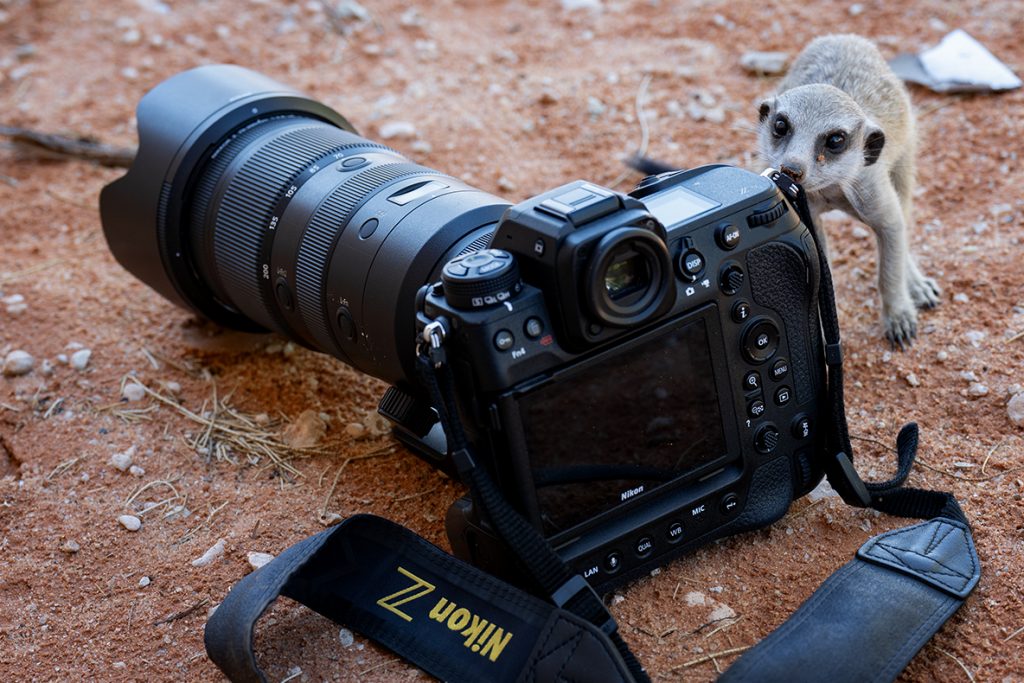
Scorpions on the Menu: A Night Hunt in the Kalahari
If you ever wondered what a meerkat’s idea of fine dining looked like, let me enlighten you—it involved a deadly scorpion, a fearless attitude, and a whole lot of sass. Out in the Kalahari, these pint-sized desert warriors feasted on creatures that would send most of us running for the hills. Scorpions, with their venomous stingers and armoured exoskeletons, are a meerkat delicacy, a crunchy treat that comes with a side of danger.
For me, the thought of eating a scorpion was a hard no. But watching meerkats go about their deadly snack time? Absolutely fascinating. That’s why Mareli and I geared up for an after-dark adventure—armed with ultraviolet lights, we went scorpion hunting. Don’t worry, we weren’t planning to snack on them ourselves (I’m adventurous, but not that adventurous). We were there to observe, document, and get up close and personal with these glow-in-the-dark nightmares of the desert.
Fun fact: under UV light, scorpions lit up like neon signs at a dodgy nightclub. The reason? A chemical in their exoskeleton reacted to ultraviolet light, making them glow an eerie blue-green. This made our night mission both slightly terrifying and ridiculously cool. As we scanned the sand for these eight-legged assassins, I couldn’t help but appreciate the meerkats’ bravery. No fear, no hesitation—just pure, strategic hunting.
But it got even better—meerkats didn’t just eat scorpions, they trained for it. Like tiny desert ninjas, the older meerkats, often the babysitters of the gang, would catch a live scorpion, break off its venomous tail, and present it—still very much alive—to the young ones. This was meerkat school, where the curriculum was How to Fight a Deadly Meal 101. The pups practised their attacks, learning how to dodge a stinger and land the perfect kill. It was a brutal but necessary skill because, in the wild, you either learned fast or became someone else’s dinner.
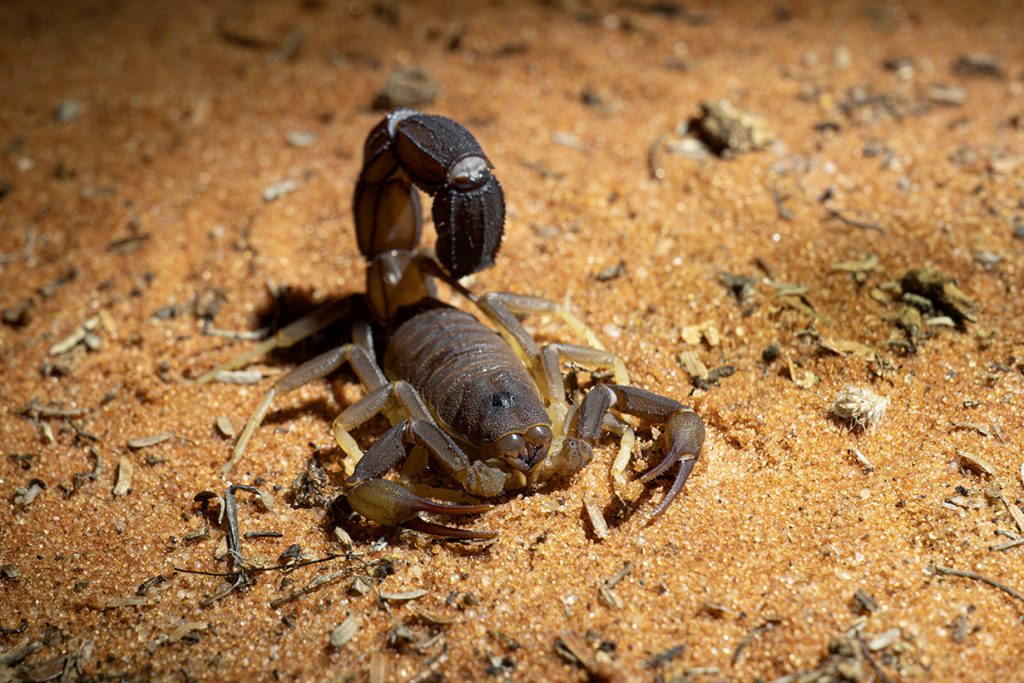
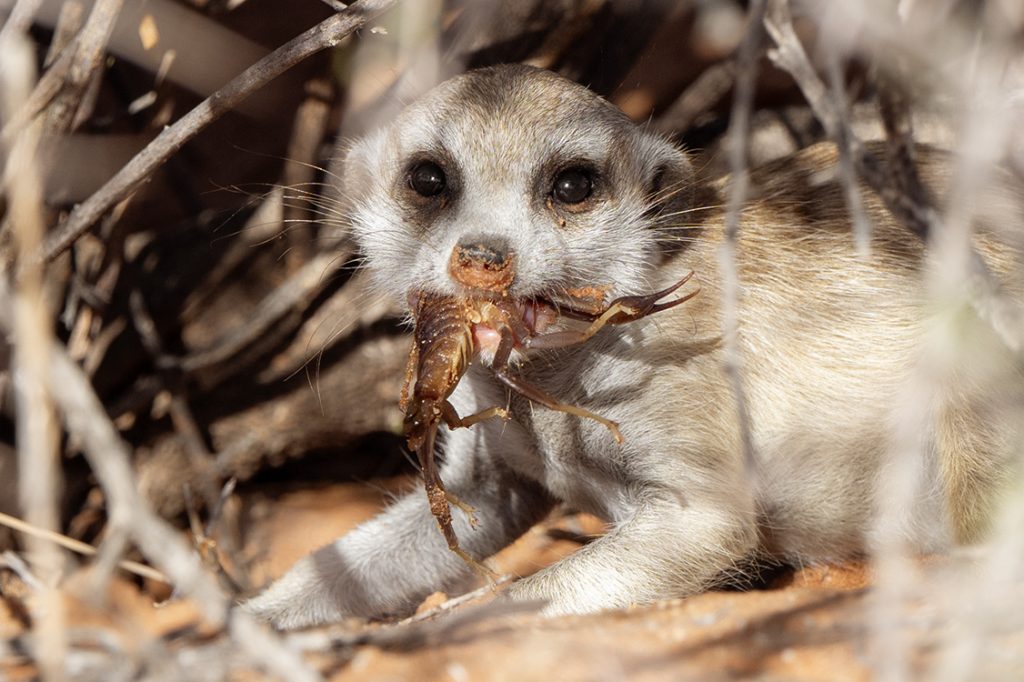
Echoes Of The Kalahari
One of the most captivating behaviours I observed was the role of ‘echoing.’ Meerkats communicate in an intricate system of vocalisations, but what stood out was how they would ‘echo’ each other’s calls. This wasn’t just about sounding an alarm—it was a way of reaffirming messages, ensuring that every gang member was aware and in sync. It was a language of survival, passed down through generations like a desert dialect.
Mareli explained, “It’s not just about safety. It’s about memory. These vocalisations hold the lessons of those who came before them. It’s as if they’re carrying echoes of the past, keeping their ancestors’ wisdom alive.”
As the days passed, I found myself deeply connected to their world. Their social structure, communication, and unwavering care for one another all mirrored aspects of human society. We, too, rely on each other, bound by history, lessons, and family and community ties.
Not long after I left the sanctuary, I received news. The matriarch had given birth to her pups. Then, as if answering an unspoken call, she crossed the border into Botswana. It was a decision that meant she and her young ones could no longer be observed or protected by the sanctuary team. It was bittersweet—knowing I had witnessed such a pivotal moment, only to have it slip away like grains of sand through my fingers.
Yet, that’s the nature of the wild. It doesn’t wait. It moves, it adapts, it survives. And just like the matriarch, I, too, was moving forward—carrying the echoes of the Kalahari within me, forever changed by my time among the wild gang.
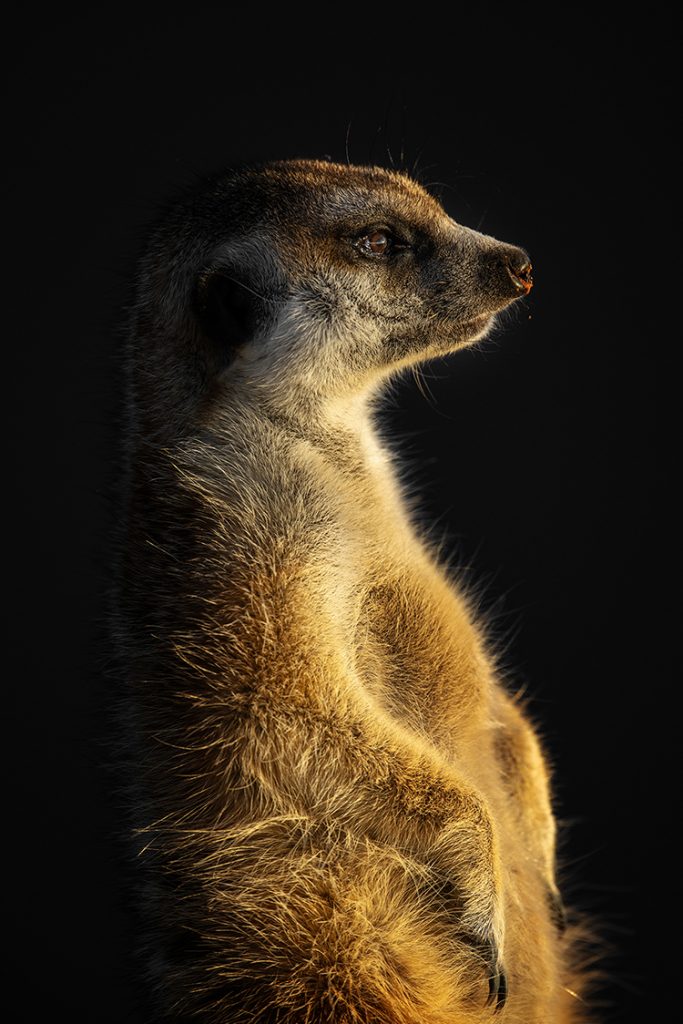
Haggi. A Victim of the Pet Trade
However, not all meerkats have the chance to live in the wild. Some, like Haggis, fall victim to the illegal pet trade. Haggis, a four-year-old meerkat, was rescued by the sanctuary after being kept as a pet. Haggi was neutered by his previous owner, and tragically, his life in captivity had irrevocably altered his behaviour. Haggi can no longer survive in the wild on his own. The wild meerkats had already tried to kill him if he was outside his enclosure, as he no longer fit into their social structure.
Haggi’s story is a stark reminder of the dangers of the pet trade, especially when it comes to exotic animals. Many people purchase meerkats without understanding their complex social needs, and the result is often tragic. Haggi, despite his rescue, will never be able to live as nature intended. His story is one of loss and rehabilitation, but it also underscores the importance of sanctuaries like this one—places where injured or displaced animals can find safety and a second chance.
The End of the Journey
As my time at the Kalahari Trails-Meerkat Sanctuary drew to a close, I left with a profound sense of gratitude and respect for the meerkats and the sanctuary that had opened my eyes to their world. Richard and Mareli, along with the meerkats, had shown me something deeper than just the behaviour of a species—they had shown me the intricate web of life, the bonds that tie individuals together, and the importance of preserving the wild in all its forms.
The meerkats, with their complex social structures, their resilience, and their ability to adapt, left an indelible mark on my soul. I will never forget the face of the matriarch, whose life I was fortunate enough to witness, or Haggi, the victim of the pet trade, whose struggles reminded me of the importance of conservation.
As I left the Kalahari, I carried with me not just the memories of my time with the meerkats, but also a renewed sense of purpose in my work as a storyteller and a conservationist. The meerkats had shared their world with me, and now it was my turn to share their story with the world.
"Wild, unpredictable, and endlessly entertaining—meerkats are the desert’s most charismatic little troublemakers, and I wouldn’t have it any other way."
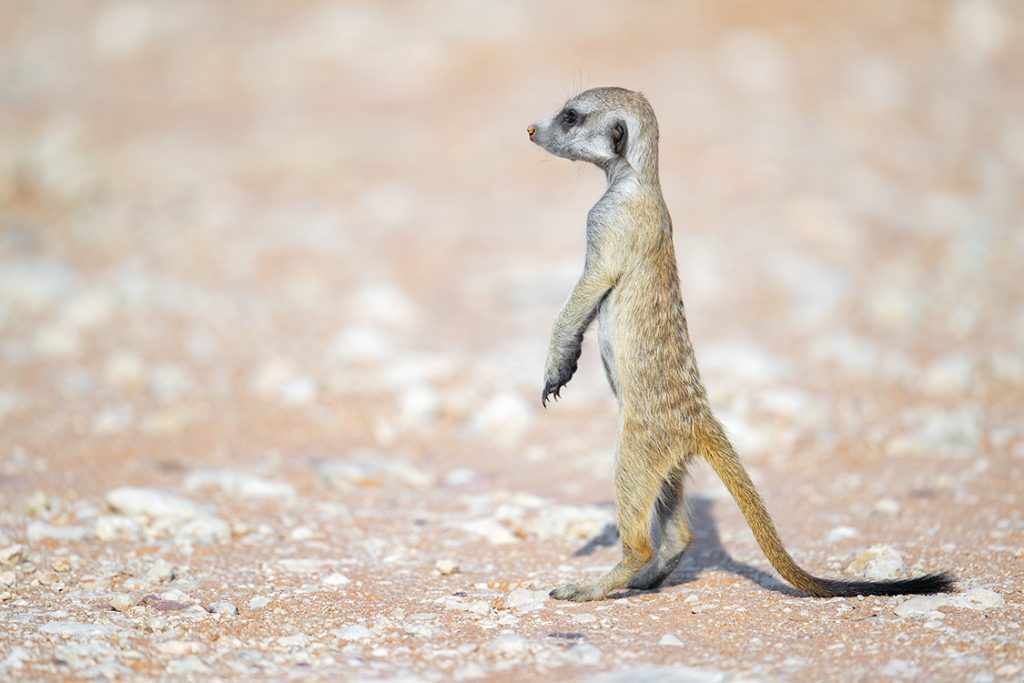
"Meerkat Gallery"
Join LensTraveller On A Journey Of Discovery. Stay updated with the latest travel adventures, inspirations and insights.
*By subscribing you agree to our Terms &Conditions and Privacy & Cookies Policy.
